Hi Everyone,
When I was thinking of a headline for this post, I debated over what it should be for quite a while. Finally, I settled on Stainless Steel Sucks.
I mean, I knew the post was going to focus around stainless steel and what the problem is. But, the reason it’s a problem is something I only JUST learned.
What I learned about stainless steel is quite disturbing. That’s why I’m deeming it public enemy number one.
Here’s what happened.
Recently, a kind reader named Janet sent me this note:
With the coronavirus on all our minds, and lots of us frantically disinfecting doorknobs and cabinet pulls, would you consider a round-up post on untreated copper and brass (which contains copper) hardware? Copper is anti-bacterial and anti-viral.
Apparently, Covid-19 stays viable on copper for 4 hours, but viable on plastics and stainless steel for 72 hours up to nine days. Numerous links available via google: here are a few:
Copper Destroys Viruses, So Why Isn’t It Everywhere?
Using Copper to Stop The Spread of Respiratory Viruses
Coronavirus Remains Infectious on Common Touch Surfaces
I read those, and a few other articles, and all concurred.
It’s true. Copper is naturally anti-microbial. And, even the really grungy oxidized version is as well. Did you know that? Yeah, probably. I was perhaps out sick with the flu the day we learned that in the eighth grade.
In addition to copper, brass, which is an alloy of copper and zinc, as well as bronze, which is an alloy of copper and tin are also anti-microbial.
Brass is about 67% copper. And Bronze is about 88% copper. Although, I could not find any studies about how long bacteria and viruses can live on those two surfaces.
But, it’s true. Bacteria and Viruses on copper surfaces die quite quickly– within four hours.
However, one of the worst materials where viruses can live for days on end is stainless steel. There are reports of four days and BEYOND!
I know. And, that’s why stainless steel sucks. Of course, I realize that we must always clean our surfaces unless you live alone. And, then you don’t have to clean anything. Haha, You’ll just recycle the same germs your body already knows and loves. Cool.
Logically, if stainless steel is so awful from a hygienic standpoint, how come it’s become so wildly popular for not only commercial kitchens but residential kitchens as well?
Good question, huh?
And not only that. But stainless steel is commonly used in hospitals as well. No wonder they say, “if you want to get sick, go to the hospital.”
I mean, scientists have known about this for a long time. So, tell me. Why isn’t the entire hospital made out of copper?
For this post, I’m focusing primarily on an alternative for stainless steel. And, also ways to use traditional copper.
Therefore, let’s begin with the ubiquitous stainless steel kitchen appliances.
Here’s what else is bothering me about stainless steel, and it’s brethren, like black stainless steel, for example.
I’m surprised that at least one kitchen appliance manufacturer hasn’t gone after a healthier surface. Now, that would be a reason to get a new range. Imagine a kitchen surface that is continuously ridding itself of bacteria and viruses? No bleach or other harsh cleaners. It is a surface that is inherently self-cleaning.
I’m not talking about spilling marinara sauce all over your countertop. No countertop will take care of that mess. I’m talking about cleaning the things you can’t see. Isn’t it ironic that something we can’t see is this enormous threat to our health and possibly our life?
Maybe germs just aren’t sexy enough for manufacturers? Well, how about now? Me thinks that now is the time we are going to see some significant changes in the home furnishings industry.
The reason is apparent.
Imagine you have three little kids who have been eating their buggers. And, then, they come into the kitchen to grab a glass of juice to wash them down. They smear their germy little hands all over that fridge, inside and out. Then, Mom comes along two hours later, to make dinner. She unknowingly picks up those germs on her hands that she just washed before beginning her dinner preparations.
Upon closing the fridge door, her eye suddenly begins to itch, and she starts rubbing it vigorously before realizing that she needs a Claritin. In the meantime, Mom just inoculated herself with thousands of viruses picked up from the fridge handle and door.
Three days later, Mom is sick with a bad cold.
But, what if the outside of the fridge had been made out of copper alloy? Most of the germs would’ve died before she got there. Yes, a few would be left. But, it takes an army of them to make you sick. I didn’t know that either. But, I’ve heard it on the news as a theory as to why some health care professionals are getting ill.
(please note that this is a little story I made up. People get infected with viruses in numerous ways. It depends on a lot of factors. And, I don’t have enough information to know if this could have happened or not. She also might’ve still gotten sick had the handle been made of copper or some other material. This is all meant to be food for thought. Thank you. )
Another really horrible material in terms of germ retention is plastic.
Oh dear. Plastic?
I’m sure that research is being carried out to figure out alternatives for stainless steel and plastic. These are two of the worst surfaces to use– anywhere.
But, one problem with copper is, do we want everything in our world to be the characteristic orangey-pinky color of copper?
Probably not.
So, then I wondered if it’s possible for copper to mimic the look of silver or stainless steel.
And, guess what? The answer is YES!
So, let me share this company that I discovered, and we’ll discuss their products. Or you can look them up below
CuVerro® is a solid surface that’s a unique class of copper.
They make sheets of the more traditional looking copper. However, I believe that it does not tarnish.
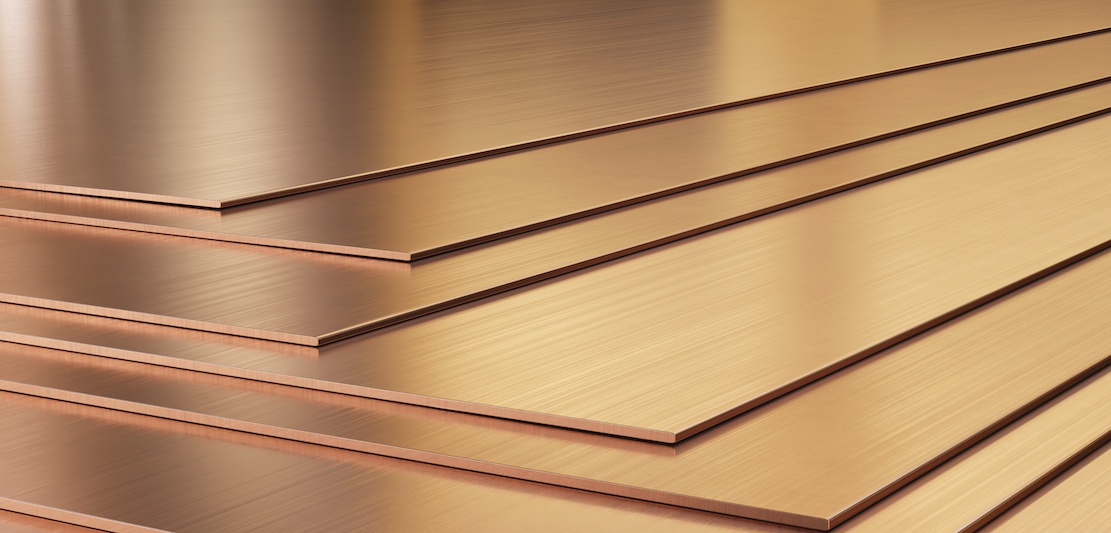
They make another copper alloy they call White Bronze
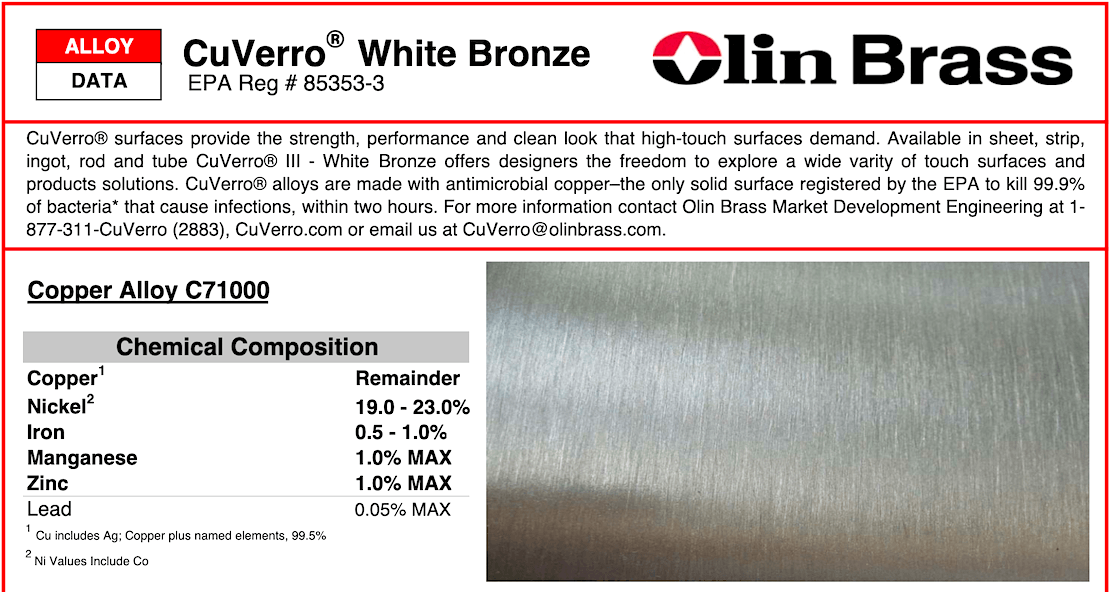
And below, I took a screenshot from their website that explains what it’s all about.
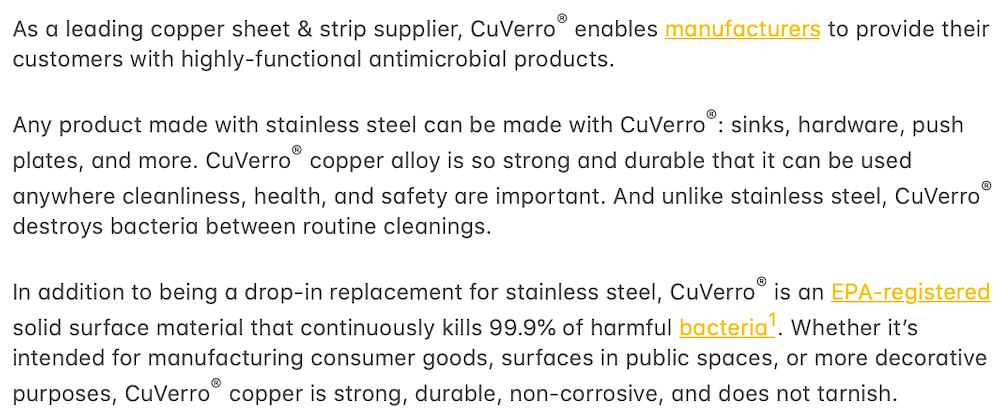
Do you see where it says that any product made with stainless steel can be made with CuVerro?
I did not know any of this before today.
There must be other manufacturers of a similar product. But, this is very exciting, indeed.
In fact, the basic idea of their white bronze is not new. There is a copper alloy called Cupronickel or Copper-nickel. Like the white bronze, it is also a copper alloy that is silver in color. Sometimes it is also called German Silver.
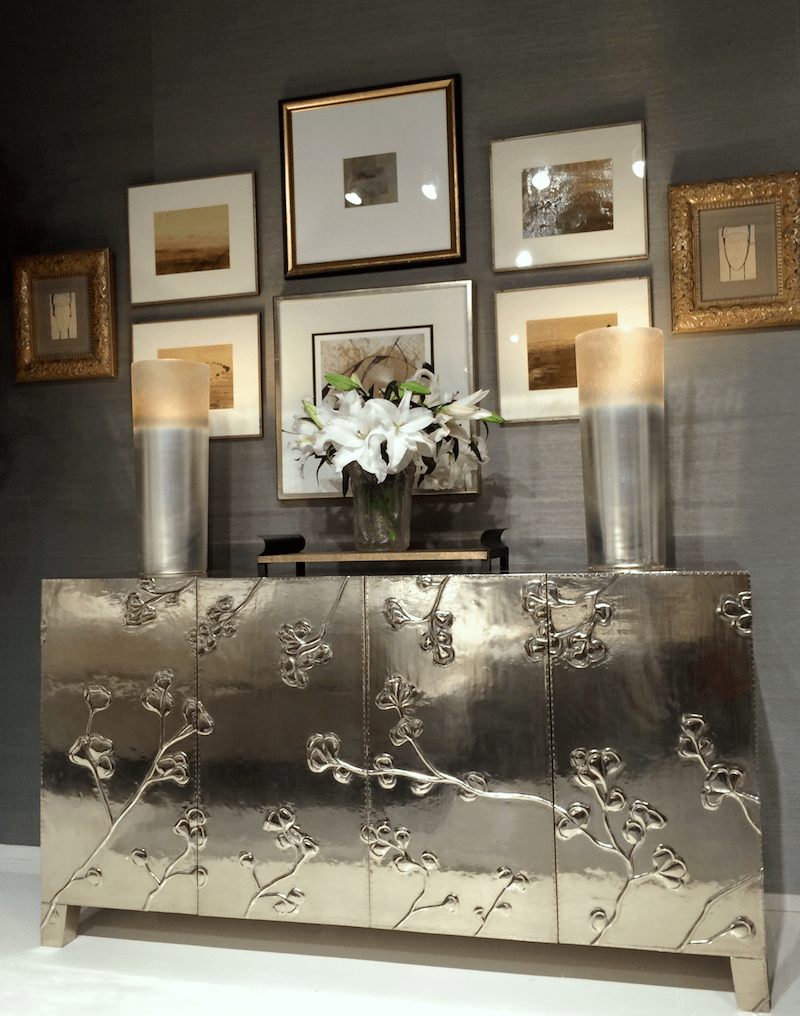
Years ago, I took this image in the Bernhardt Showroom at High Point of a credenza made from German Silver. Same thing. But, this one has a coating over it.
This silver-toned alloy of copper, nickel, and other metals has a multitude of uses.
But, common ones are for musical instruments or jewelry that is silver plated. Actually, anything that is silver-plated. It makes sense because if the plating wears off, the color won’t be significantly different.
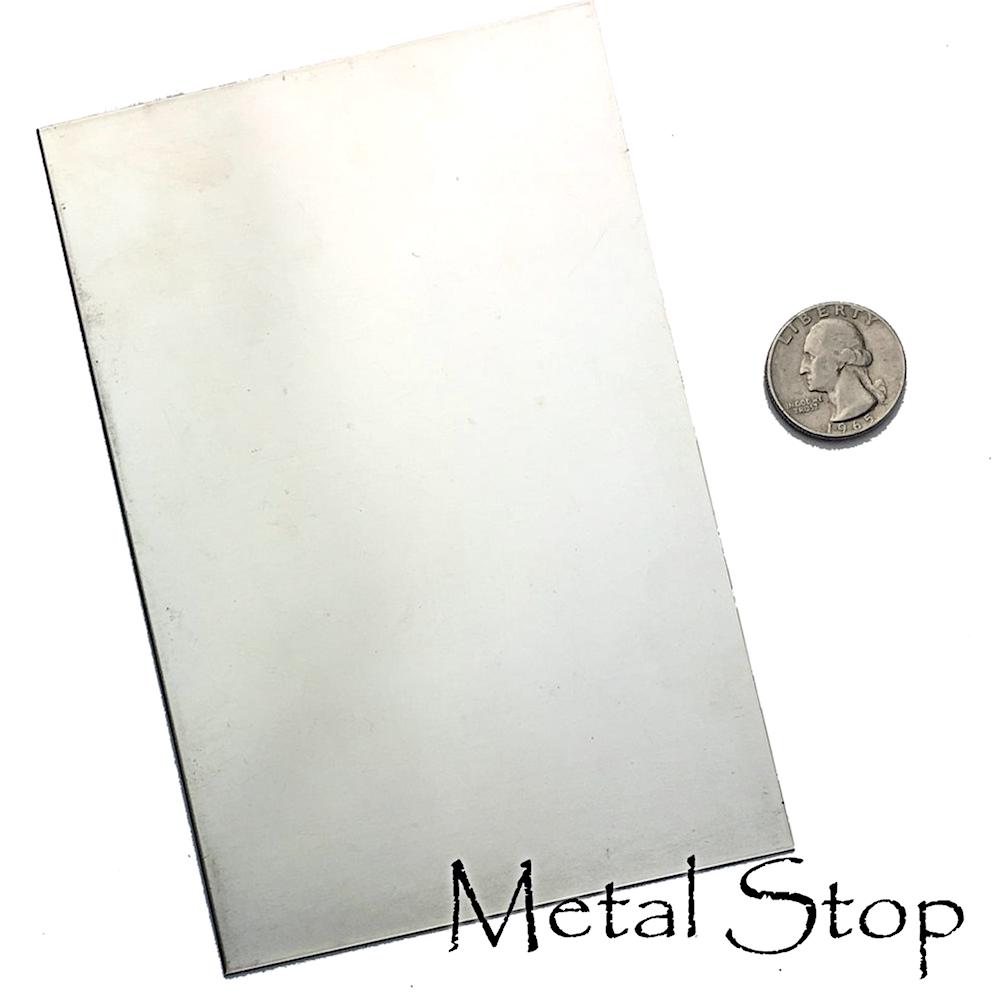
Here is a piece of copper-nickel I found on Etsy.
In the meantime, although not common, I have seen some appliances with a copper finish.
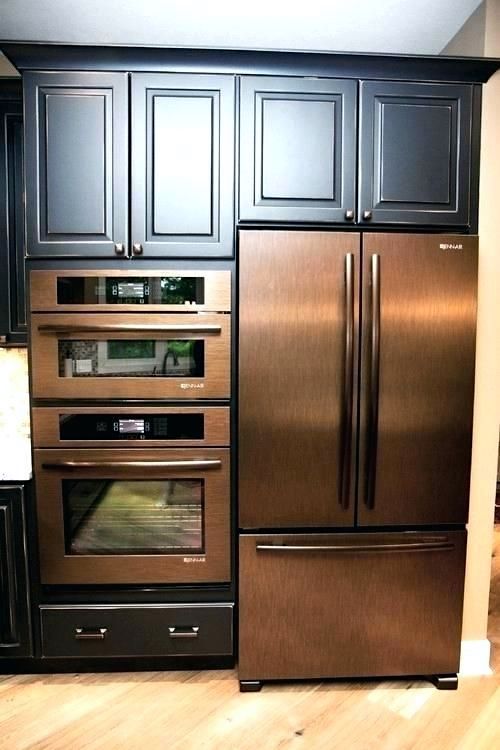 Sorry, source unknown. It seems a little heavy. I think I’d get sick of this look, pretty fast. But, the cabinet color is fine with the copper. Maybe if the fridge was clad in the cabinetry material, it would work better for me.
Sorry, source unknown. It seems a little heavy. I think I’d get sick of this look, pretty fast. But, the cabinet color is fine with the copper. Maybe if the fridge was clad in the cabinetry material, it would work better for me.
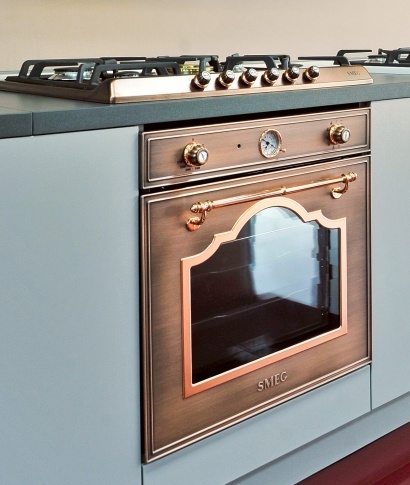
Interesting door.
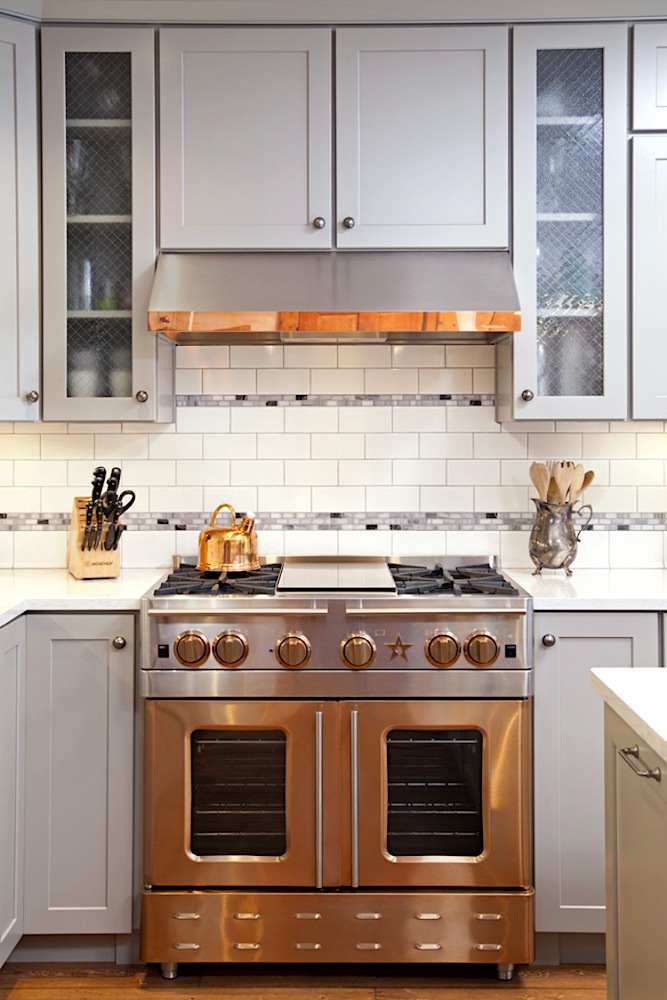 Bluestar makes a copper range. I love their line; remember this post from three years ago?
Bluestar makes a copper range. I love their line; remember this post from three years ago?
And, they were featured after my trip to KBIS in 2019.
But, I’m just not crazy about this orange-y metallic finish. I think I’d get sick of it pretty fast.
Below, is another example of a Bluestar copper range.
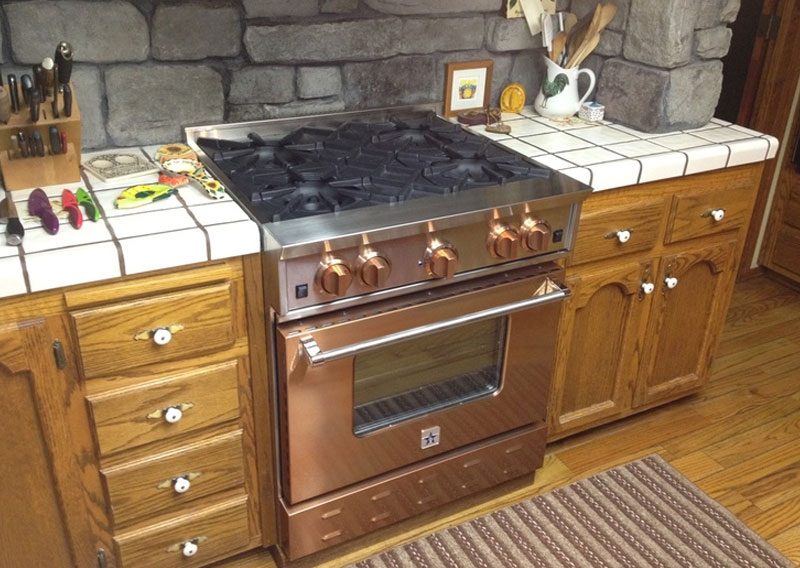
Uh oh… I hope whoever did this is not reading this post. I mean, they put a $6,000 range in a dated oak kitchen? And, to boot, it clashes with the more yellow-toned wood.
So, if you are going to do any copper appliances, what color cabinets would look best?
Well, before I get into that. Let’s talk about other places in the kitchen where one would use copper. And, I’m talking a more traditional copper.
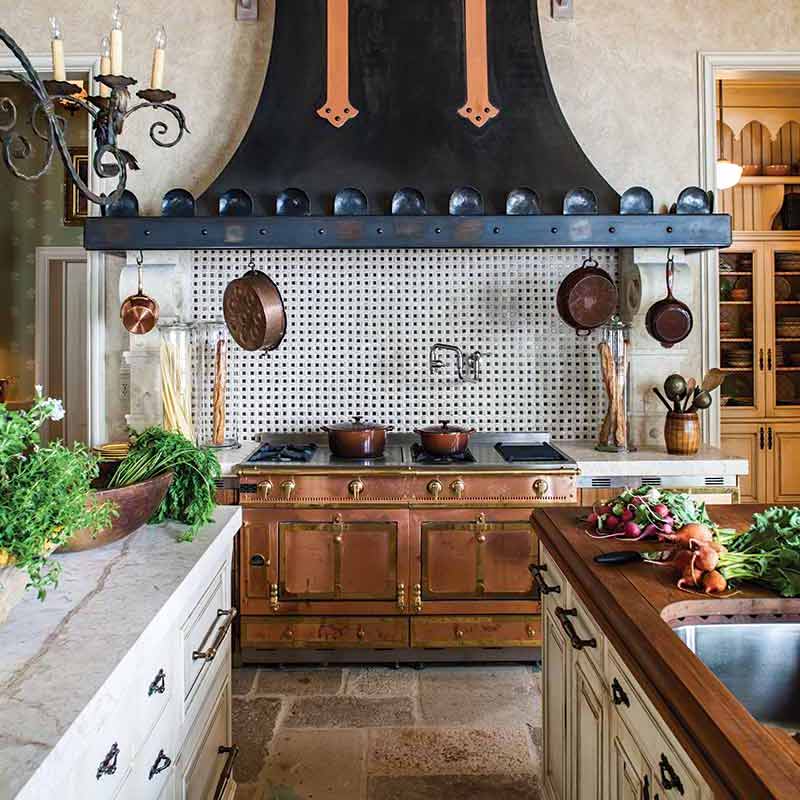
Dixon – Photography by Erik Kvalsvik – Southern Home Magazine
Holy wow! A copper La Cornue. That’s some kitchen!
These items in the kitchen can be made out of copper or a copper alloy:
- countertops
- sinks
- hardware
- plumbing fixtures.

And, Williams Sonoma has a slew of small appliances and cookware made from copper.
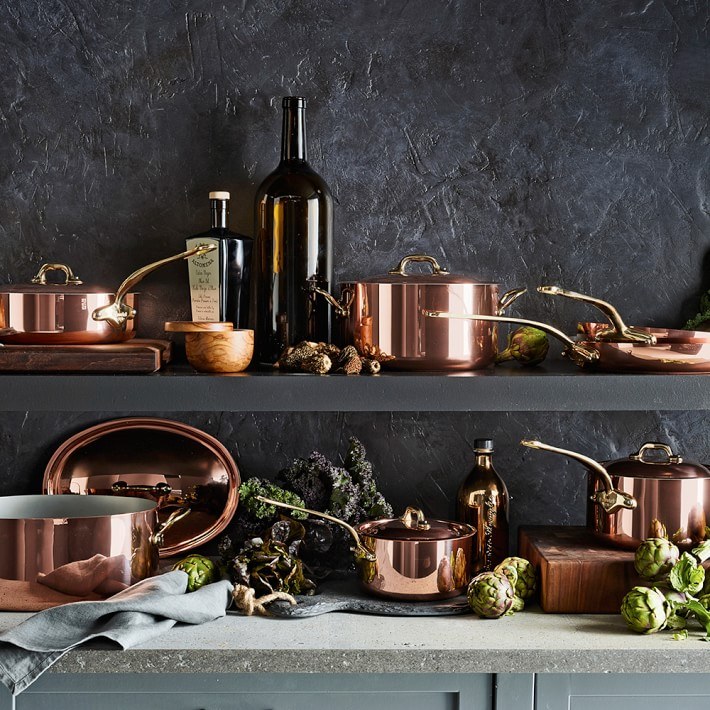
Mauviel Copper 12-piece cook set
Can you mix metals? Yes, absolutely. In fact, I think you should. You know, I thought we discussed this topic. But, I can’t find it now. Sorry about that.
But, there are few ideas in the following images, at least. We’ll also go over some of the best colors to go with copper finishes.
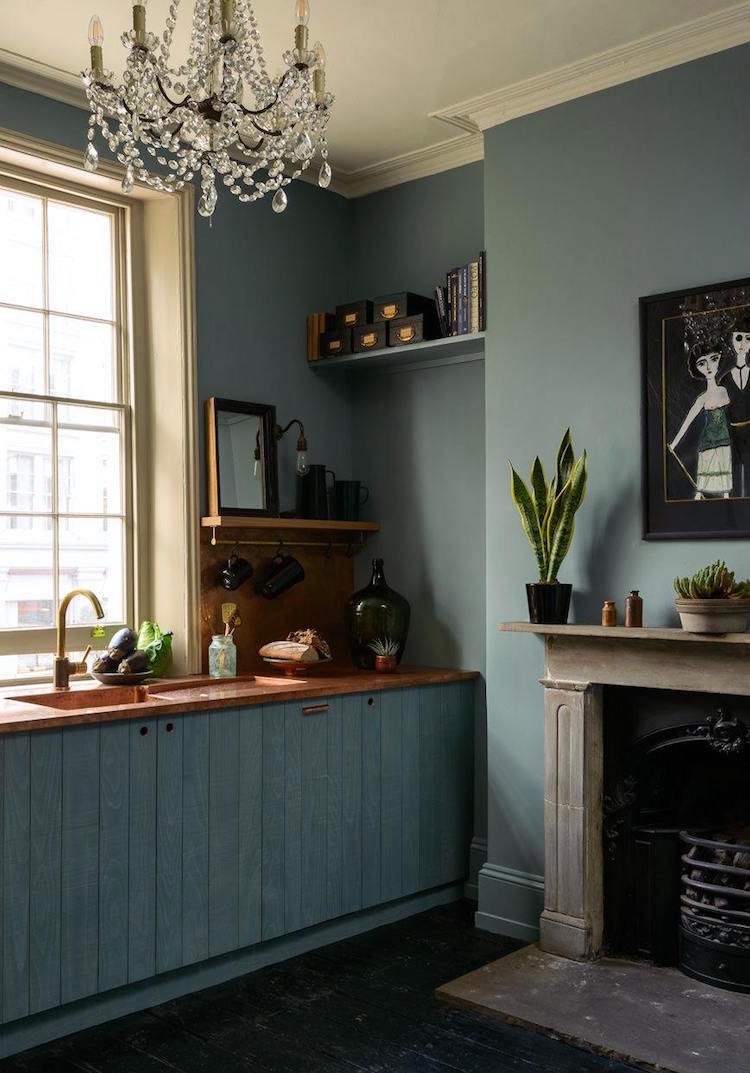 Remember this beauty from DeVOL? I love dark greens, teals, and dark blues with copper.
Remember this beauty from DeVOL? I love dark greens, teals, and dark blues with copper.
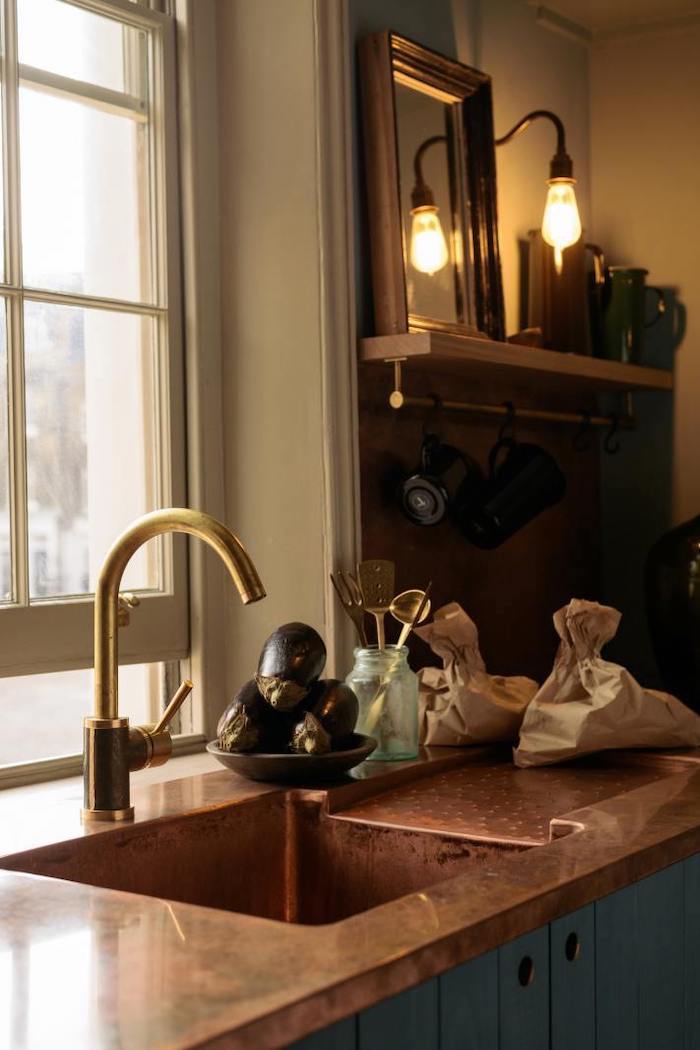
Above is a detail shot, showing the brass faucet, integrated copper sink, and countertop.
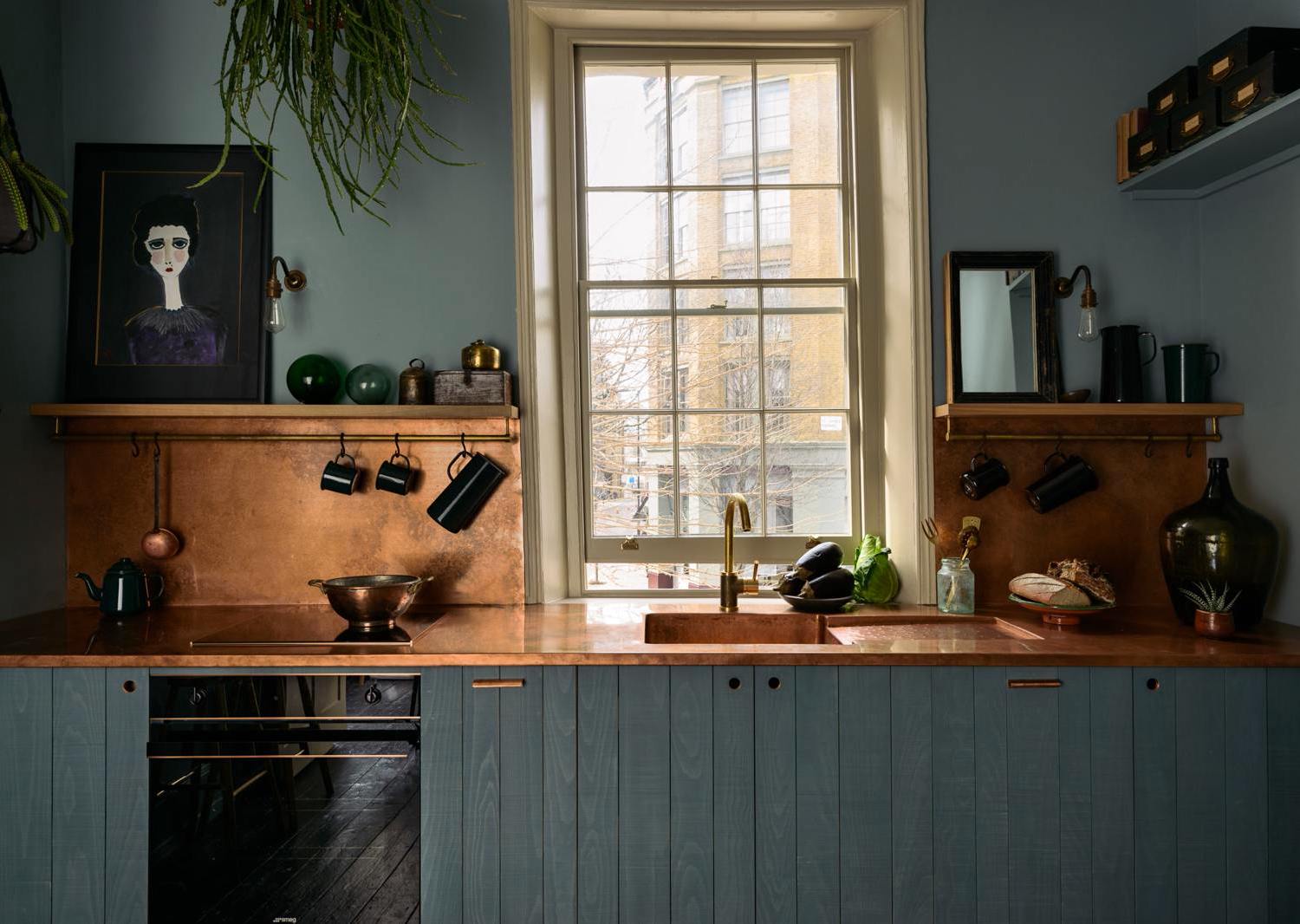
Another shot of the beautiful DeVOL kitchen with a copper backsplash, countertops, teal cabinetry. And, I love the black accents. Beautifully done!
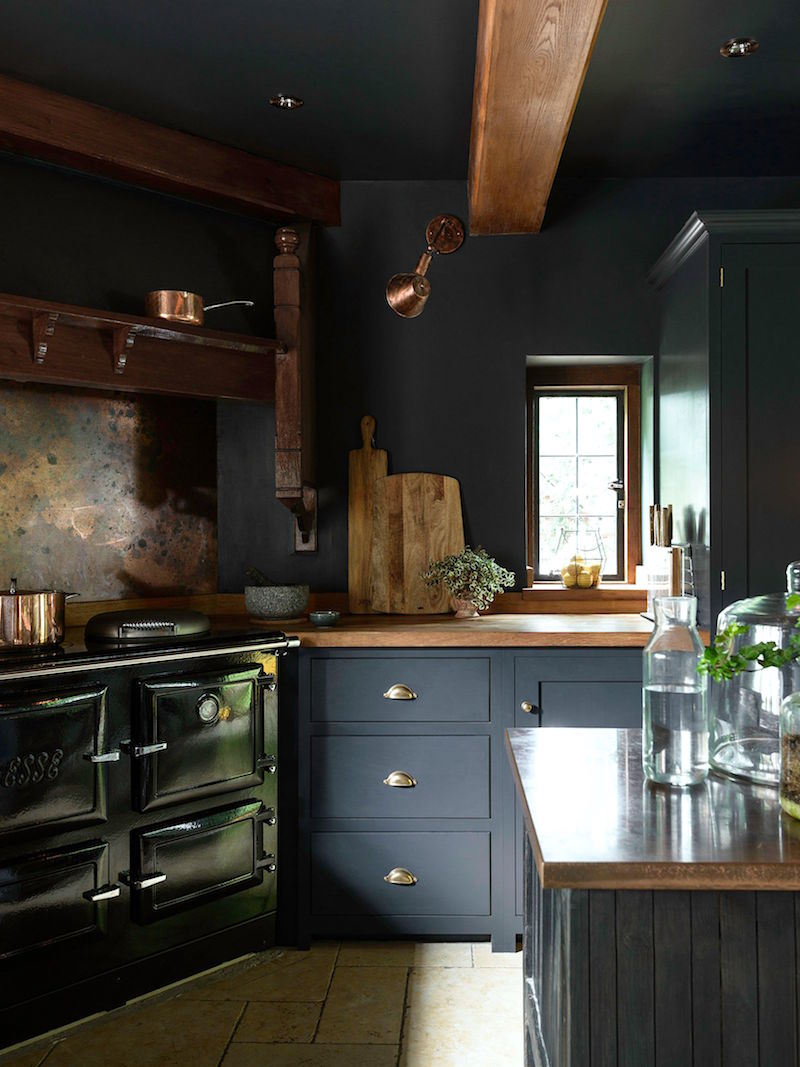
While the perimeter countertops appear to be wood, the island might not be. In any case, they could be copper. And, that would look lovely with the dark, cool gray cabinetry.
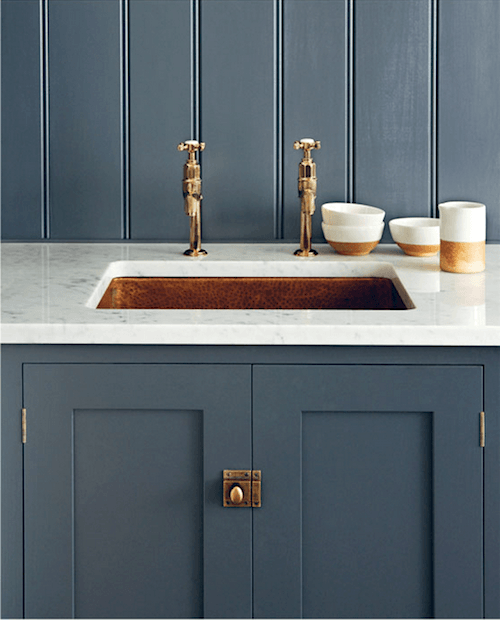
Another lovely DeVOL vignette. I believe that the taps are brass; the sink is copper, of course. And, the hardware appears to be copper too.
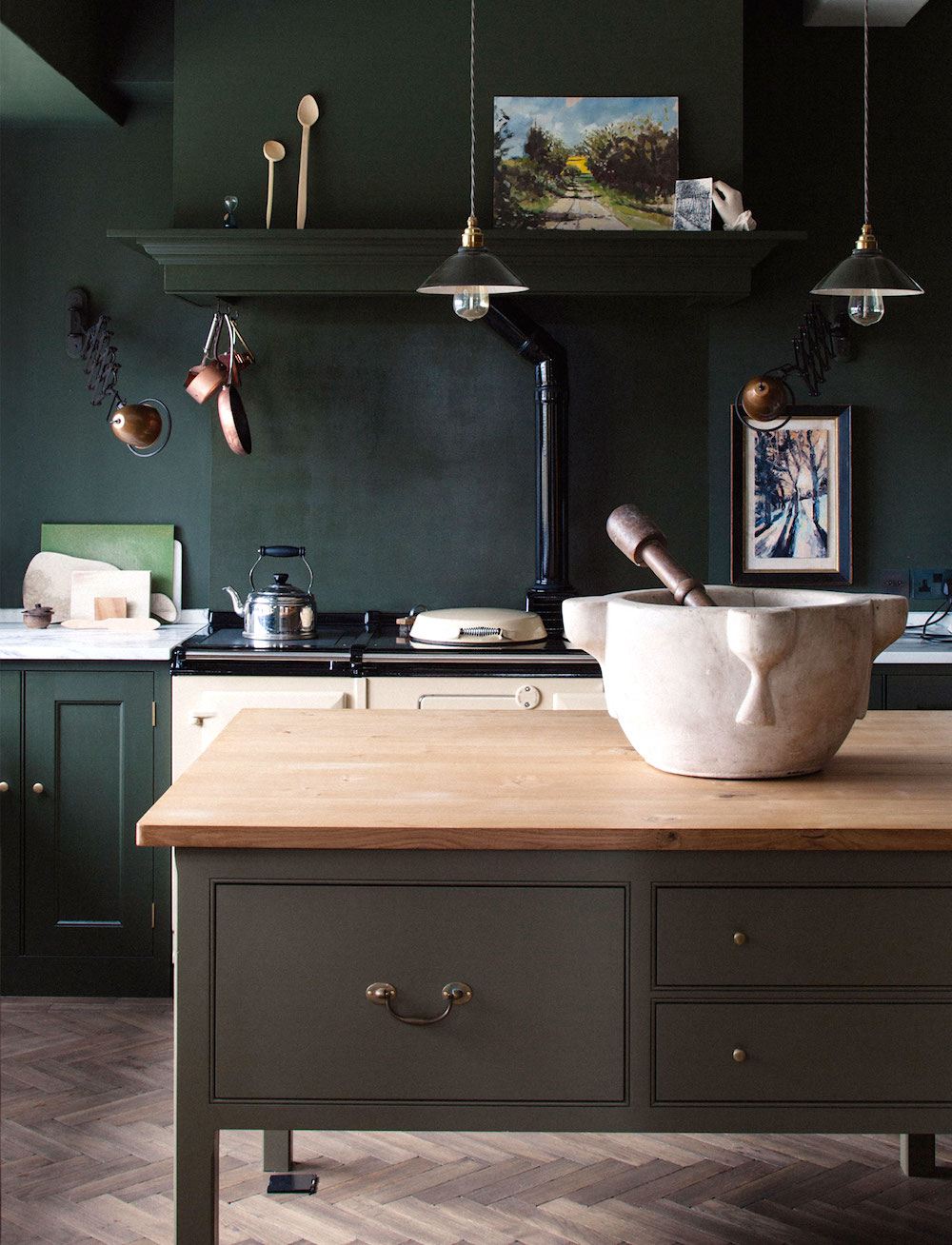
I think that copper would look great in this kitchen by Plain English Kitchen.
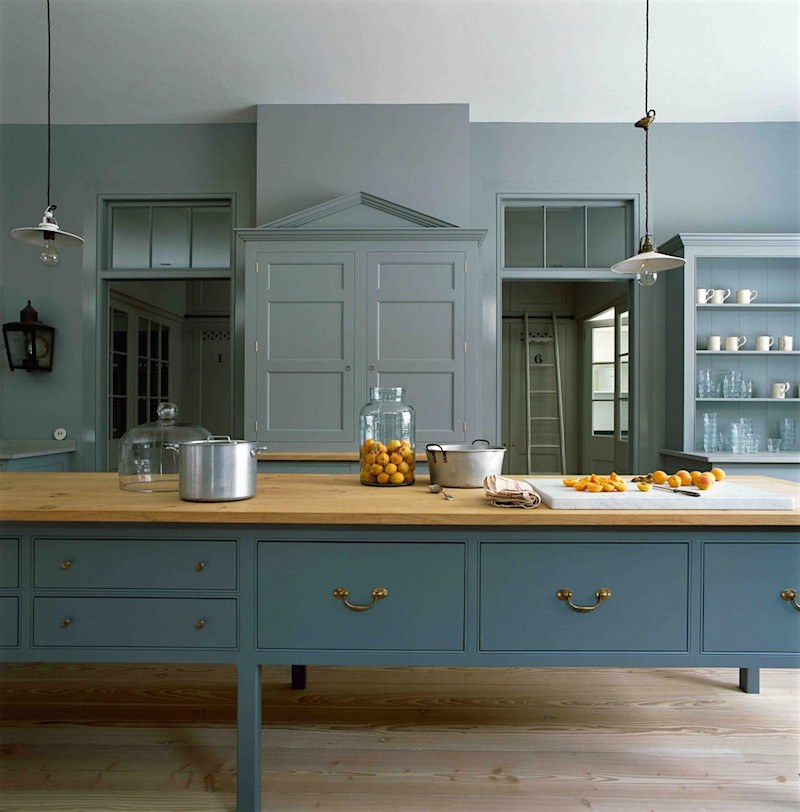
It’s difficult to tell but in this kitchen by Plain English Kitchen (one of my favorite blog posts), the hardware appears to be copper.
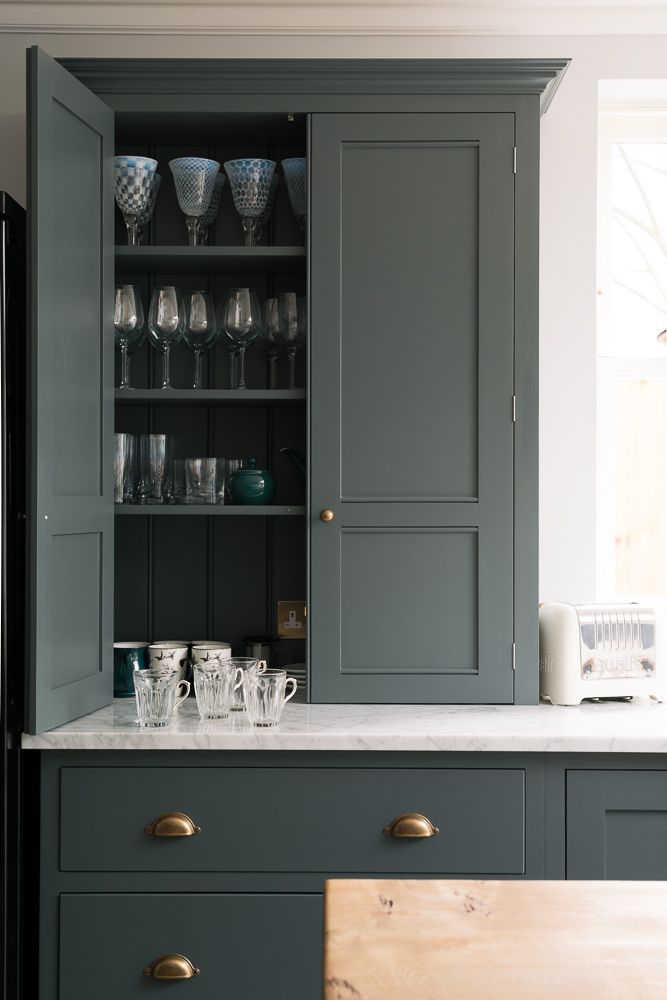
And, one last image from DeVOL with wonderful copper pulls and knobs. I love the colors they use for their cabinetry. For similar colors, please check out this post where I attempted to crack the code, using Farrow and Ball paint colors. This cabinet color looks a lot like Farrow and Ball Down Pipe.
If you’d like to see Farrow and Ball paint colors compared to Benjamin Moore, go here.
 Philippe Côté – blue and copper accents in a stunning kitchen
Philippe Côté – blue and copper accents in a stunning kitchen
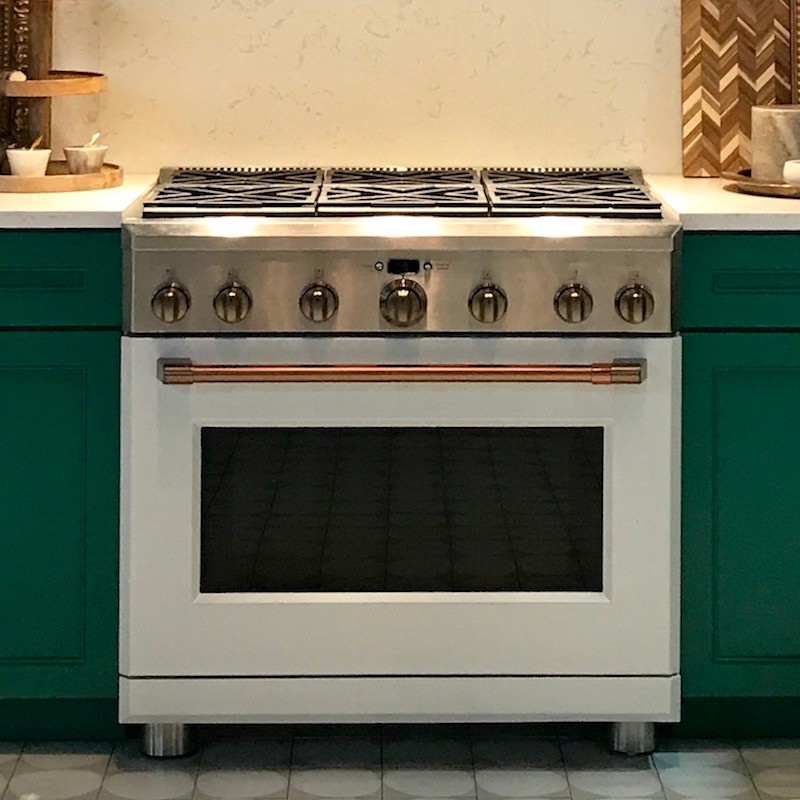
Remember the cafe matte white colorful kitchen appliances – mixed metals.
You might want to know if I think that a copper range would look good in a white kitchen. My opinion is to stick with the accents.
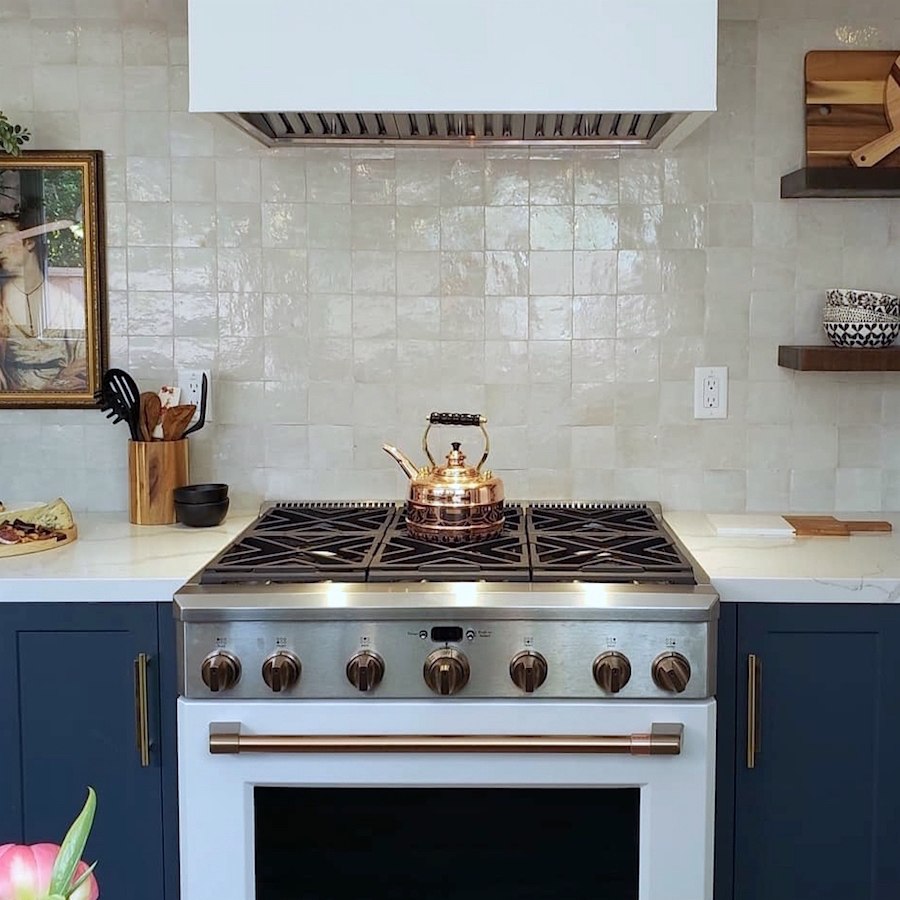 Kismet House – kitchen remodel – Cle Tile – cafe-appliance-range – Another fabulous kitchen.
Kismet House – kitchen remodel – Cle Tile – cafe-appliance-range – Another fabulous kitchen.
For more of the gorgeous Zellige tile, go here.
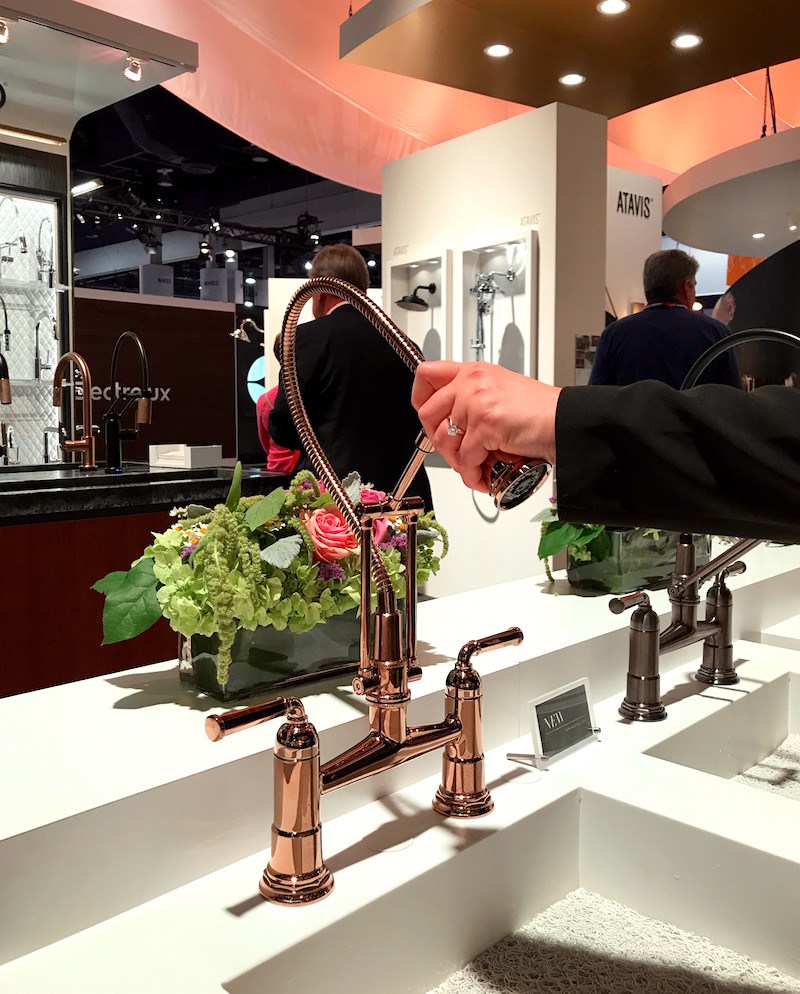
Brizo rose gold or copper faucet at KBIS 2019
In conclusion. I am curious to see what innovations will be happening in the home furnishings industry due to the virus.
And, for once, I’m actually excited about it. The reason being that these innovations will be done to make our homes safer as well as beautiful.
These will become the new trends that are based on function and need, not just because a manufacturer is trying to sell something new.
Of course, I’ve only begun to scratch the surface of materials that go in our kitchens. I didn’t go into all of the countertop materials and which ones are the best in terms of antimicrobial properties. That’s a different post.
But, one thing I predict is that we’re going to be seeing a lot more of the cupronickel products, or something similar to replace stainless steel.
I think that when the word really gets out that viruses can live on stainless steel for four or more days, there will be a demand for a different material. Well, that’s what I’m predicting.
We’ll just have to wait and see what happens when the dust of dead germs falls.
I hope everyone is keeping safe and well.
Note: 10 hours after publishing.
A few of you are being downright nasty in your comments.
Please stop, before you lash out in any way, even if you feel justified. You aren’t. Not on this blog. This is my digital home and you are my family. In my family, we speak to each other respectfully, at all times.
Go beat up your pillow if you’re angry. I hate having to delete comments. You don’t have to agree with anything I say. You don’t have to understand my point, either.
The only thing I ask for is kindness. We are all under a lot of stress. Please, let’s just try to love each other instead of tearing apart. Unfortunately, I’ve had to delete several comments. If it persists, I will turn the comments off.
xo,

PS: Definitely, check out the HOT SALES pages this week.
And, especially the Mother’s Day gift guide on the HOT CLOTHES PAGE.
Delivery times are far slower than usual, and this is the time to order Mom a gift if you’re planning on getting her one. Also, you’ll see a mini widget on the main Hot Sales page for a fabulous sale of Juliska products.
In addition, I’m going to be making a beautiful flower guide for the most stylish flowers and plants to get Mom. You’ll want to order soon, and then state when you want them to arrive. I’ll have that ready to go on Tuesday. In the meantime, you’ll see a few ideas for you to ponder.
Related Posts
 How I’m Developing My Interior Color Palette (Parts 1 and 2)
How I’m Developing My Interior Color Palette (Parts 1 and 2) Laurel, Why Does My Decorating Look So Awful?
Laurel, Why Does My Decorating Look So Awful? The Guaranteed Way To A Beautiful Room (It’s Not The Wall Color)
The Guaranteed Way To A Beautiful Room (It’s Not The Wall Color) The Magnificent Front Doors of Beacon Hill
The Magnificent Front Doors of Beacon Hill Hate Your Open Concept Floor Plan? Here’s How To Fix It
Hate Your Open Concept Floor Plan? Here’s How To Fix It Furniture Terms You May Not Know, But Maybe Should
Furniture Terms You May Not Know, But Maybe Should The Classic Kitchen – A Complete Source List
The Classic Kitchen – A Complete Source List





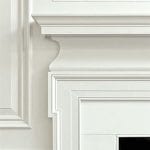






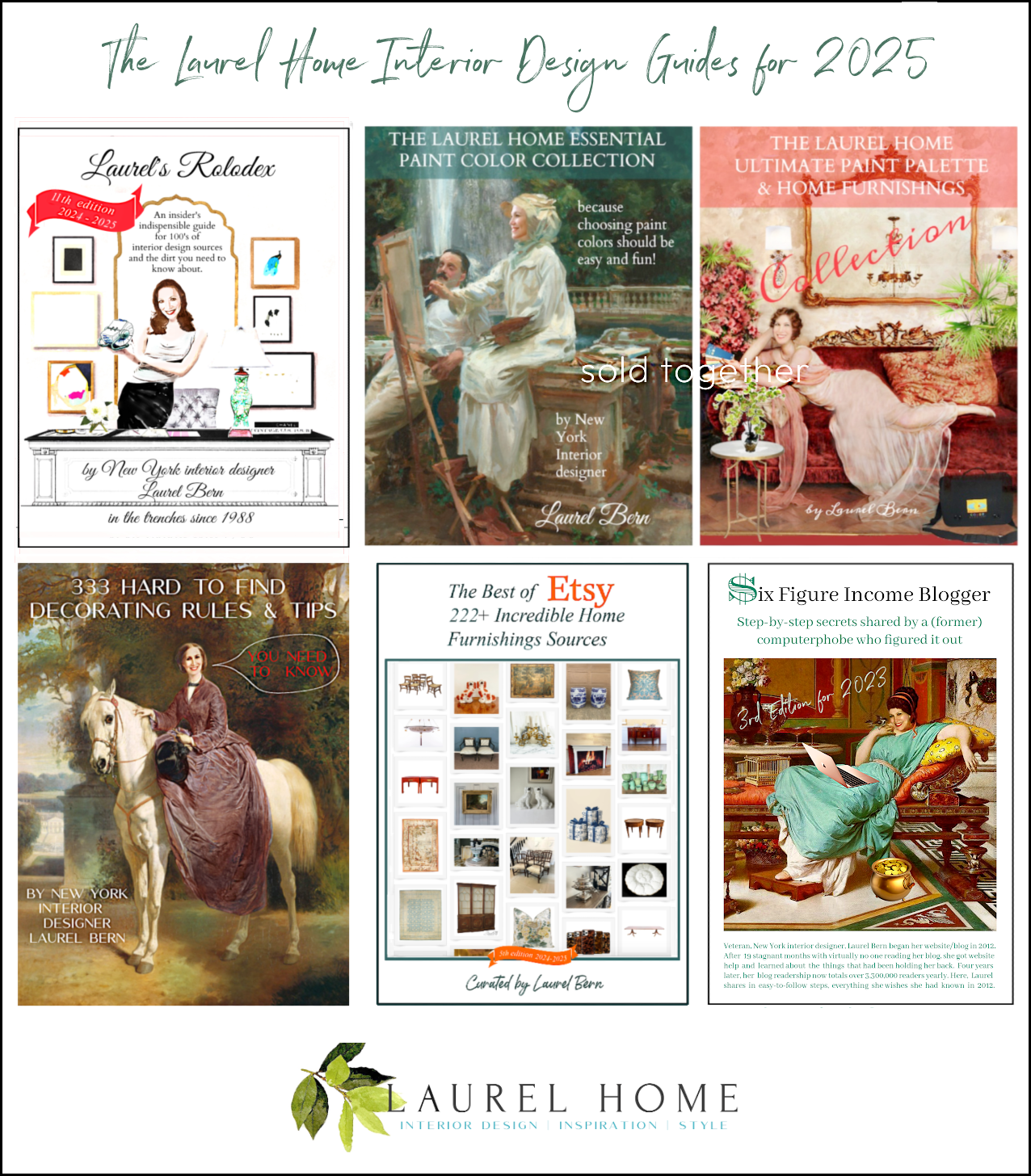

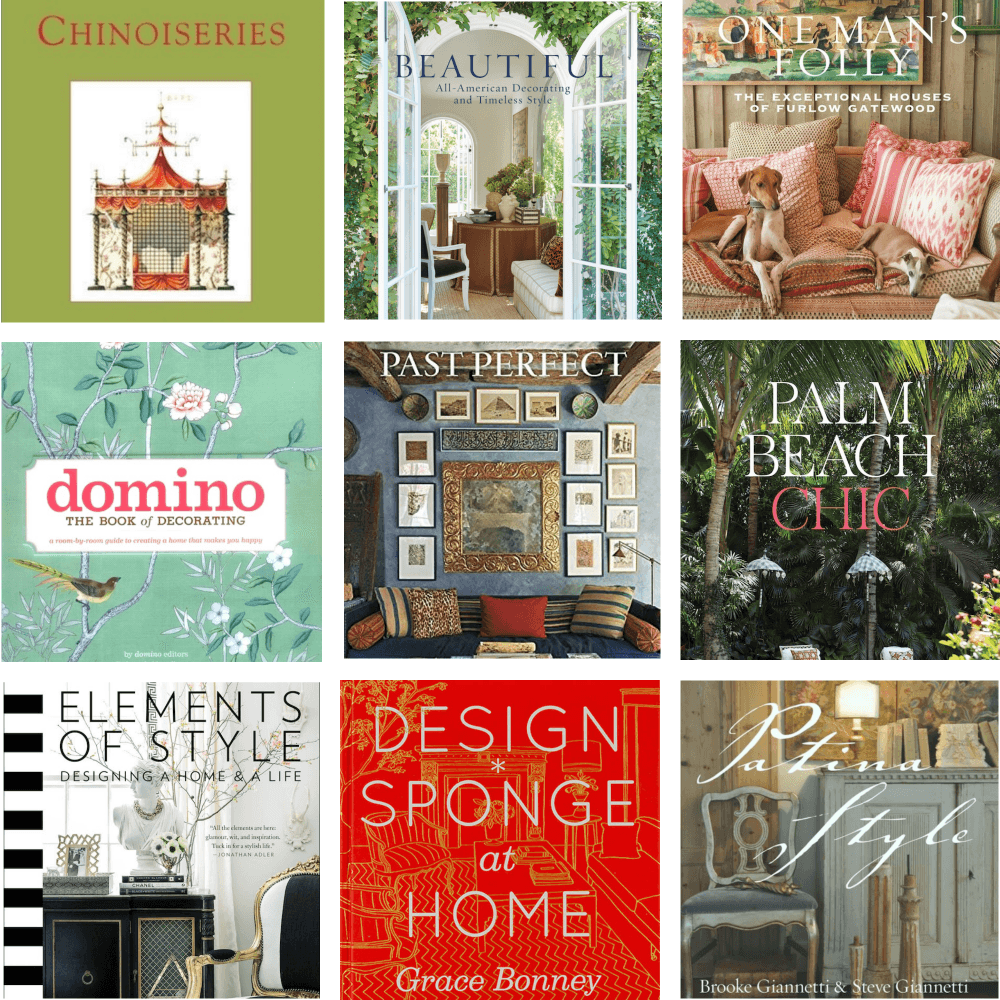

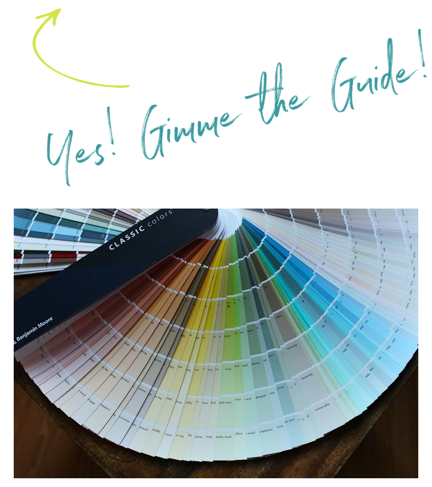
112 Responses
Very (VERY!) late to the copper party, but I just wanted to add, if anyone is considering a copper sink, they could look at Dino Rachiele’s copper sink. He’s a small independent manufacturer down in sunny Florida. I did a ton of research (of course I did!) for our kitchen reno, and ended up spending more than planned on one of his large workstation sinks, farmhouse style, solid copper. I knew vaguely about the useful aspects of copper, but now I’m even happier we did. I love DeVol Kitchens, they’re so pretty, but their copper sinks, to me, look too small and too deep. Great article, as always, Laura, thanks. Off to catch up on the rest now!
Hi Laurel, my parents are medical professionals (a nurse/practice manager and doctor) and reckon copper is a great material to use. High copper content really does help kill germs quicker. I find that where we are in Australia too the costs of brass and copper fixtures aren’t too much more than stainless steel too (everything is pricy here lol). But yeah, it’s not a bad idea to have kitchen cupboard knobs or door handles in copper for example!
Good article.
Kind regards,
Courtney.
Thanks for your concern, but my comment was not really about my nickel allergy. But, since you brought it up, I’m also allergic to surgical steel, even when used in wire for stitches. I found that out after needing one piece of a steel stitch removed after it was accidentally left in the wound. I could never have a surgical steel hip implant. I also can’t wear silver jewelry, or some gold jewelry, and have trouble with those little hooks at the back of the neck on some dresses. I have no problem with my stainless steel sink or anything other stainless appliance. I wouldn’t have an allergic reaction to a copper sink with nickel in it either, which is what the comment I responded to implied. Copper, like any other metal goes in and out of fashion, as far as jewelry or interior design use. People in the copper manufacturing industry are talking about copper right now, due to the new research being done as to its possible anti-viral properties. It has been known for ages that it is anti-microbial. Also, as far as copper being harmful to humans, it is not harmful to the thousands of people working with it in the many industries where they handle it on a daily basis.
Rebecca,
as another person with a nickel allergy, I wanted to add that MOST stainless steel, including so-called “surgical” stainless steel, contains nickel. The nickel free stuff is a specialty product. I can’t wear “surgical” stainless steel earrings. Brass keys almost always contain nickel to make them harder. After a day of going in and out of locked rooms at work, my palms would be red, swollen and itchy–nickel in the brass alloy was the hidden culprit. I have no idea if brass kitchen hardware contains nickel, but I would get a sample and test before installing.
FYI, copper is already used in the kitchen for plumbing. The amount of copper used in plumbing is second only to that used in electricity. And, most people know copper is a necessary mineral and can be bought in the supplement section in any pharmacy. People with fish tanks know that water that has gone through copper pipes can be bad for fish, and yet copper products are used to treat fish for some diseases. As a person with a nickel allergy, I know that some stainless steel has nickel in it, and that I can’t wear so called hypo-allergenic earrings made of stainless steel. I just had to get this off my chest.
As a PhD materials chemist with some experience specifically in copper and nickel containing nickel alloys, are not a harmless panacea to microbial woes. As others have stated the salts (tarnish/patina) that form on the surface are toxic. They’re not ‘kill you instantly’ toxic, but not the sort of things you want to be ingesting continuously either. I wouldn’t worry about a few door pulls or a refrigerator handle, but I would be judicious. My bigger concern is with the nickel alloys. 10-20% of the population, myself included, is allergic to nickel. It might be okay for rarely touched items to be 20% nickel, but that defeats the purpose of using it for its antimicrobial properties.
Dear Laurel,
Firstly I want to preface this by saying that I love your posts. I sometimes go a while without reading one, even though I am a subscriber, because I go down the rabbit-hole reading all the links, leading to more links and I don’t always have time for that.
I now work in food safety, but have previously worked in research laboratories and did jewellery making as a hobby.
Commercial kitchens, laboratories and hospitals use stainless steel because it does not (generally) corrode, does not stain, does not change colour through patination and is very hygenic when frequently cleaned (with soap or detergent) and sanitised (alcohol, bleach, hydrogen peroxide, clorhexidine or similar).
Yes, you are right that copper is anti-microbial, so is silver. But copper and silver are more expensive metals and they patinate and tarnish, they are also far softer than stainless steel. Stainless steel counter surfaces are already very expensive.
Perhaps the anti-microbial copper will take off in the home environment, but not commercially. It’s too expensive and the patination and tarnishing mean it’s a pain to clean. I believe the beautiful images you showed with pristine copper would have the copper coated with laquer, varnish or even plastic. That’s how my copper sheets came for jewellery making: with a plastic layer, and a beautiful shine, once that was lifted the copper was exposed and soon started to change colour (oxidise). If the kitchenware is coated with varnish or similar layer, it will not be more hygienic than stainless steel. Similarly I believe that covering a copper fridge door with a cupboard panel will also not be better than stainless steel, and aren’t fridges mostly plastic inside in any case?
A paper I found* showed that copper was more effective than brass at reduction of bacteria. Depending on the alloy for some bacteria the unoxidised surface was better at killing, for others depending on the bacteria an oxidised surface was better at killing. This means that yes, the grungy oxidised copper is still effective at killing microorganisms. This particular study was on bacteria, but it is probably also true for viruses. What was also shown is that surfaces with higher copper content are better at killing. This suggests that alloys which are either stainless steel looking, and/or do not oxidise are probably not as good at germ-killing.
Ultimately hospitals can make you sick because there are many sick people in hospitals, not because of stainless steel. I would be concerned that people would let their guard down and clean and sanitise less if they thought they had a special germ-killing surface. Sanitising, or germ-killing, can only be effective if the dirt, or gunk is removed (cleaned with soap or detergent and water) off first. In some labs we had dodgy looking formica-type surfaces. We never had problems because we cleaned and sanitised like crazy. This is also true for handwashing, it is better to rub thoroughly with soap and rinse with water (and not sanitise) than to use sanitiser alone, because germs will cling to the dirt and oils, and the sanitiser may not be able to penetrate to kill them. (Of course, if you have access to hand sanitiser and not soap and water, use sanitiser.)
Research is always ongoing, one food manufacturing client was interested in a long-term antimicrobial based coating that claimed to be a “long-term sanitiser”. I looked briefly at the research available on this silane treatment and it seemed promising. Depending on the cost, perhaps copper would be cheaper (but probably not).
Long story short, a surface needs to be properly cleaned to be hygienic. Copper is expensive and the discoloration may not be acceptable to all users. As far as the aesthetics are concerned, I have nothing constructive to add, design and aesthetics are Laurel’s forte.
https://www.sciencedirect.com/science/article/pii/S0010938X17313963
*Impact of oxidation of copper and its alloys in laboratory-simulated conditions on their antimicrobial efficiency by Walkowicz et al. in Corrosion Science, Aug 2018
Great post! Sorry you get nasty comments. I totally don’t understand but that’s why a lot of sites have turned off comments.
Keep well!! Love your blog – always informative, fun and beautiful. 🙂
Ohh, I did not know that. well, I’ve been doing a crappy job of cleaning them. I’ll change to the spray and wait.
Does cleaning surfaces with soap and water work the same as washing hands with soap and water? Or dues the virus “cling” to surfaces and that’s why it’s more difficult to rid them of the virus? I just haven’t been able to find much info about that. Thanks!!
I would check with the CDC for that type of question.
I appreciate you sharing the information about how long the virus can live on different surfaces. I have always been intrigued by a copper sink because of the anti-viral benefits. I have been put off by the orangey color and am glad to hear of the other colors that might be available. Thank you.
I really enjoyed reading this post! As a designer I have wondered how the pandemic will affect interior design. I love this take on the subject!
Please feel free to cost everything in copper and brass! I will not cause I like stainless steel, even if I have to clean it, disinfect it etc etc. Try cooking in an uncoated copper pot for awhile, have fun! Cheerio! 🤣
Hi Jack,
No one is suggesting that you give up your stainless steel (or stainless steel look). Or, cook in an uncoated copper pot. It seems to me that you missed my point.
In fact, if you go back and read again, hopefully, you’ll see where I talk about a copper alloy that LOOKS like stainless steel but has the ability to kill lethal viruses far more quickly because of its high copper content. The product is a silver color that looks like stainless steel.
Basically, what I am talking about is an improved stainless steel with better antimicrobial properties.
Thanks so much for this very insightful post! I knew this about silver which is in my Norwex cloths but not copper.
I thought you might be interested in this article I found where the coronavirus was just tested. As you predicted, it was killed quickly by the copper countertops. Amazing!
https://www.cleveland.com/news/2020/03/why-copper-could-help-prevent-future-pandemic-and-what-it-does-to-coronavirus.html
Thanks for sharing this, KT. It’s well-written. Excellent article. A quote: “It has to do with the fact that copper is schizophrenic.”
Now, imagine if I had said that. Oh my. I would’ve gotten skewered from now until next Saturday. But, he also says: “a study from 2015 by the University of Southhampton in England that found copper can help prevent respiratory viruses from spreading.”
And, he talked about the possibility of infusing plastic with copper to make it better at killing of coronaviruses.
However, cost has been a factor in the past for it really taking off. I daresay the cost of not being proactive in fighting the progression of this disease is unimaginably worse; not to mention the obvious priceless cost of human life.
Thank you very much for writing such a timely and interesting article. My husband and I renovate houses and I will be designing the kitchen in the house we own but can’t work on due to Stay at Home order. I can see finding ways to incorporate these surfaces in this house will enhance its chances for being sold. And I can’t imagine why anyone would be mean to you. I am sorry.
I watched “Little House on the Prairie” this weekend and back in those days people had an extremely hard life. Makes me realize out lucky we are today and grateful.
They really did. I loved the original books. I read all of them back in 1973.
Laurel, Any post of yours that has DeVol pics is A-OK ++ with me.Sorry you’ve had to deal with nasty comments.Perhaps there will be more use of copper in future,perhaps not. No question that a “safety” argument is a very compelling one…that is how I convinced hubs & got my beloved anti-microbial soapstone counters:-)
Do you think homebuilders may evolve toward planning multiple home work zones and/or less open plan spaces? Not suggesting the return to the rabbit warren of yore but these days,seems like half the folks I know are thinking about putting up a wall or two down the road.Two people working from home plus homeschooling can shift perspective.”a house is a machine for living in”,indeed. Stay healthy, you rock!
Hi Varya,
I’m not sure about the answer to your question. Some of my clients from 10-15 years ago had homework rooms.
I would have liked to have read the trashy comments; I’m bored as hell.
haha
Fun post from my perspective. Four hours on any surface in a kitchen is a long time when one is using the room. That is why if I had a young family I would be wiping it down constantly in these times. As it is my stainless steal gets wiped down almost daily. It is just hubs and myself with an occasional visit by our daughter who buys our groceries. That leaves a fairly constant environment. Mail, packages and deliveries are all possible contamination issues.
Now for the copper. Lovely look if done correctly. Copper can be rather costly. I enjoyed the comments by others.
I have been thinking about outside copper flower pots and having a few items inside to make them look intentional.
Laurel, your blog is a favorite read. I do not post often but when I have time to read them I find the comments are often enlightening and interesting.
Firstly, I read a peer reviewed research article on coronavirus survival on particular surfaces and Laurel is 100% correct. The research was pre-COVID-19, but looked at coronavirus viability on various surfaces. Surfaces containing copper did indeed lesson the time the time the virus was viable. The longest they got it to survive was 21 days. That was on a solid surface with no copper. I’ll go see f I can’t find the study and post it.
Copper has serious environmental drawbacks though. Copper mining leaves gigantic pools of toxic tailings that inevitably leak into waterways and pollute clean water. Copper is toxic to fish at very very low, parts per million.
It’s pretty to look at, but I cannot support copper mining at the expense of clean water.
Here’s an article about hundreds of birds being killed by polluted water from just one copper mine, but the problem is worldwide: https://www.google.com/amp/s/amp.theguardian.com/us-news/2017/jan/23/geese-die-montana-toxic-mine-epa
Very interesting and sad about the birds.
I heard good things about soapstone being antibacterial when I was looking at materials for my kitchen.
Thank you for this timely post. I enjoy reading your blog, and appreciate all the thought and work that you put into assembling. You also have a great sense of humor. I had a decorating business, ending in the late 90’s. We have seen the styles come and go, and the traditional bent is still beautifully relevant.
Thank you Laurel. Very informative.
I love your blog!
Hi Laurel,
Another great article and more interesting and beautiful photos.
Siemens produces built-in and free-standing refrigerators with anti-bacterial interiors, by including silver ions in the plastics.
https://appliancist.com/cooling/refrigerators/siemens-coolconcept-refrigeration-line.html
If you want to fight bacteria in the kitchen and the house, I do recommend Dettol Antibacterial Surface Cleanser Spray. See https://www.dettol.co.uk/about-us/understanding-coronavirus/
Jessica
Laurel, thank you–not just for this post, but for every post lately, in which you’ve taken the time to address the seriousness of the pandemic. From my perspective, you’re doing a public service. Doubtless you have readers in places where coronavirus is not even taken seriously. I see you using your capital–earned trust–to bring people an important awareness. Also, thank you for the insights on colors to pair with copper. Lucky me–very timely advice!
Very interesting post. Thank you! And it truly might be prescient. There are so many things that influence trends and styles. I have wondered what this unique moment in time might usher in as far as styles and preferences. Antimicrobial is certainly going to be a buzz-word for quite awhile. I think you may have a bit of a crystal ball into the world of style for the next several years with this post!
I second the recommendation of O’Keefe’s Working Hands! I’ve been using it for years, and it’s the BEST. I discovered it in the bathroom at the barn where my horse was boarded, and never looked back. And, did I mention that it’s reasonably priced? I bought a tub of it (I like the tub better than the tube – easier to get it all out) for each of the kids to save each of their hands.
P.S. I also second the sentiment about some people having a shot of anti microbial bourbon, but it really shouldn’t take THAT to get people to behave nicely.
haha
Thank you for this timely and informative post! I, for one, did not know about copper’s antimicrobial properties. And to think someone is manufacturing it in a way that it doesn’t tarnish—I’ve never really liked copper patina, so I’d love to have a copper sink or appliance that stayed looking that pinky orange color. 🙂 BTW, the tile in the photo from Kismet is gorgeous!
Don’t think about the nay-sayers. If someone doesn’t like your posts, they don’t have to read them! I love your blog, and I wish you all the best always.
Does anyone know how cast iron enameled surfaces do? I am thinking of the American style vintage farmhouse sinks. I am promoting this type of sink for our next renovation and if it were also anti-germ then it might help with husband.
Talking about copper controlling pathogens, I thought you might be interested to know that the first known fungicide was discovered in 1807 when a Monsieur Prevost in France incubated the spores that he was studying in a copper vessel and found that the tiny amount of dissolved copper killed them. When I teach this module (I am a plant pathologist) I speculate that since he was experimenting at home, he was “borrowing” Madame Prevost’s copper cookware for his experiments and she was likely not pleased about it. It always gets a laugh. The details from an article I wrote are below if anyone is curious about copper fungicide history (or uses for putrified urine).
1807 – The First Fungicide
B. Prévost discovered the first chemical means for controlling {plant] disease in a practical way in 1807. Bunts and smuts of cereals had been a key limitation to cereal cultivation for centuries, appearing unexpectedly on healthy-looking plants that should have been producing grain. Prévost was the first to observe that spores, which grew into tiny germinating “plants,” caused wheat bunt. He then made the serendipitous observation that a weak copper solution (generated when he held the spore suspension in a copper vessel) prevented their growth. Through experimentation, he demonstrated that farmers could control bunt by wetting wheat kernels with a copper sulfate solution. Previous methods of bunt control required steeping the seeds in salt water and lime or putrefied urine, which were not very effective (18). Copper-based seed treatments remained popular in some countries, including France, through the end of the 20th century.
Thanks so much for the information, Carla!
There is something know as dwell time, which is clearly noted on the label of commercial cleaners used in the hospital. The shortest dwell time, or simply the length of time the cleaner must remain wet to kill the pathogens, is 2 minutes. So the simple spray and wipe up with a paper towel is not as effective as one would think. I myself spray, walk away, come back and finish. Corona viruses will not survive that.
Yes, that is true. Very important point. I read that yesterday, as well.
Copper is a beautiful metal, and I was aware that it was resistant to bacteria and viruses. Personally I find brass and copper to be more attractive than stainless, nickel or chrome, but that’s just a personal preference. Stainless steel can be sterilized though, which is probably one reason why it is so prevalent in operating rooms.
I don’t understand why in the world people would react so negatively to a post such as this – you’re absolutely right about copper, Laurel. Oh well.
This would be another post, and correct me if I am mistaken, but aren’t there now fabrics that are bacteria and virus resistant? It seems to me that I read somewhere about airlines using them to upholster their seats. (Now if only they would make them wider and with more leg room!)
Yes, there are fabrics that are antimicrobial. I believe most of the indoor/outdoor fabrics fall under that. But, they need to be modified to make them so.
Well, I was enjoying your creative blog post until I reached the end. Discourteous comments? About what? oh, don’t tell me; I don’t want to know.
Wonderful blog post! I’ve always loved the look of copper but I was also not paying attention back in 8th grade, so I didn’t know that it’s antimicrobial & antibacterial, either.
Your blog always teaches me something valuable, and in such a fun, conversational way. Thanks again, Laurel.
I agree with your title! Not a stainless steel fan, but on board for germ-free finishes. As long as an anti-microbial surface could be easily cleaned and have pleasing color selections, I could be easily convinced.
That white brass or German silver is really beautiful. However, I personally would not use it in a high touch area because of the high nickel content–equivalent to the nickel of a U.S. nickel coin that cause nickel allergies in many store clerks. Like 17% of women in the U.S.(https://pubmed.ncbi.nlm.nih.gov/19831422), I have developed a nickel allergy. Nickel allergies are permanent and become more likely with repeated contact. Mine is so severe that I now react to nickel in my food, which means no chocolate, ever, and only very limited amounts of nuts and beans. I also have to avoid cooking in stainless steel, especially if the food is acid or simmered for a long time. so a bit of a warning,
Great post and a perfect way to blend what’s on all of our minds at the moment and interior design! My thoughts and prayers are with all of you New Yorkers right now. These are trying times and all the dissention is doing nothing to help. Never once did I see you suggest that copper countertops would prevent someone from getting Covid. On the topic of the biocidal effect of metals (fun fact: it’s called the oligodynamic effect) one of the approved EPA disinfectants for SARS-Cov2 is silver citrate at a .003% solution with a 60 second contact time before the virus is killed (that’s less than most bleach products!) I purchased a .24% solution at lotioncrafter and diluted it at a 1.25% rate (6 g per 16 oz) for a .003% disinfectant solution if that’s helpful to you or anyone else. Much love, Sara
A few people have talked about copper cookware. Heat kills microbes, so the antimicrobial properties of metal a pot is made of are irrelevant.
I love copper cookware because it conducts heat so well. The pots have to be heavy gauge, not the cheap ultra-thin ones meant to be decorative. The traditional tin coating is the most non-stick metal you can get. It is delicate, but good copper cookware can be retinned and last for 100 years or more. Tin linings should not be used with acid foods. (Not sure how safe tin is—it’s been used for thousands of years, but many tin salts are poisonous. I sue it but not with acid foods or long simmering.) They actually make silver coated copper cookware and if I ever win a mega-million lottery, I will get me some. Copper cookware also comes with stainless steel linings, but they stick, so I don’t like them. Please be aware that uncoated copper cookware or even cookware with a damaged tin coating that lets the copper peak through is dangerous and CANNOT EVER be used for cooking.
My own copper pots have iron handles. Brass is prettier, but it is such a good conductor of heat that I burned my hands on it before I decided those pans were just for decoration and gave them away.
I think that people like copper pots because of the heat conductivity and because they look pretty. @FaithMD on instagram has a beautiful off-white kitchen with a LaCanche range and a gorgeous set of copper cookware.
I enjoy reading your posts and this was beauty for our eyes and a distraction from the heavy news of today. Copper is mostly too expensive for us normal people in large quantity and some finishes that look like copper are something else made to look like copper without copper’s inherent anti-microbial properties. Just the look.
I believe that the finish on the appliances in photo with black? cabinetry is something JennAir tried to introduce as an alternative to stainless but it wasn’t touted as copper. It didn’t succeed.
I think the photo of the range and fridge, side by side, is most likely faux copper. It certainly looks it.
Hi Laurel,
You’ve brought up an interesting issue. I’m sure there are marketing executives all over trying to come up with new ways to sell products in this new world we’re living in. I saw a commercial recently for a pizza place that stated they wouldn’t touch our pizza once it came out of the oven. My goodness!! What were they doing to the pizzas before we knew of the Coronavirus? Lol.
Knowing that copper has a leg up on keeping us healthier is fascinating. I wonder if it will start being a big seller. The world is certainly changing.
Take care.😘
Hi Mary,
I predict that copper IS going to be big. Of course, some of it will be hideous, per usual. As for pizza not being touched. I hope not. But, why mention that in their advertising? Now, they’ve planted an idea that their pizza might be touched.
However, I do think we’re most likely going to be seeing a lot more gloves and masks for quite some time. I’m hoping that they can make some that come with a built-in cooling system. They are bloody hot!
Thank you so much for this article. I’m the Janet you mentioned. What a thrill. A few comments:
I love, love, love the trend to living-finish, un-coated brass (or copper)hardware and faucets that has been trending in the last few years. Bad 80’s brass has a coating that would totally negate anti-microbial properties since the touch surface is just a kind of plastic. Also it’s ugly. Laurel, could you do a round-up of reasonably priced live finish brass and copper doorknobs, faucets and cabinet hardware? It’s not always clear on-line which are live finish without writing to the manufacturers, and I find it really hard to judge quality and style on-line. Really just interested in stuff I can do myself right now without having people come into my home.
I personally do not like the look of copper appliances. I doubt that they have an uncoated finish, and I seldom touch anything but the handles and knobs anyway. Though I wouldn’t refuse that LaCornue if anyone wanted to send one my way. 🙂 I think some stoves and refrigerators have replaceable handles and knobs-will have to write to manufactures. I love the look of stainless with brass handles.
I had no idea people would be so angry about the statement that copper has antimicrobial properties. Will it prevent you from ever catching anything? Of course not. Will you get sick just from using plastic and stainless–of course not. Does using copper mean you don’t have to clean? again, of course not. But it might help some, and gives me a way to justify thinking of getting something I love anyway that tends to be a bit pricier than the big box specials I usually end up with.
Hi Janet. Thank you for the idea! This post might not be what you’re looking for either. It’s about doorknobs and it’s from the summer of 2018. There might be another one with knobs. There are some knobs and handles for individual kitchens scattered about.
hmmm… that gives me an idea.
Thank you, Laurel, for giving me a reason to not look at my copper sink with disdain. I like the sink itself, but it is an apron front and the front is stamped with a floral motif. I’ve thought about trying to hammer it in, but it’s an under mount sink and if it has to be replaced, I will have to remove my gold granite countertops… on second thought, maybe I am on to something! Well, thank you for the post😀
Dear Laurel, I want to let you know that your posts are always the highlight of my day because they are full of creative problem solving ideas & beautiful pictures. You always give my husband & me a smile on our faces with your lighthearted prose along with very helpful & beautiful decorating ideas. Don’t let naysayers get ya down or prevent you from continuing your fabulous posts!!!
Thank you, Suze. It’s a difficult time for many people. I am very blessed. So many people are truly suffering for a multitude of reasons. The posts are mixed. It felt right to do this one because a lot of people want to know what to do. The truth is, no one knows for sure. However, my thought was that perhaps there’s a material that looks and performs like stainless steel but has better naturally occurring antimicrobial properties. I was very excited to learn that there is.
Of course, there may be other factors that I’m not aware of that would make this product unsuitable for kitchen appliances. However, the company said that anywhere stainless steel is used, this white bronze can be used as well.
So, my point is if I were buying a new fridge and wanted stainless steel. Would I want to purchase one where the germs lived for at most a few hours or a few days? If that statement is true and all other things being equal, I would choose the former. Frankly, if it was a year ago, I wouldn’t be giving any of that a second thought.
BTW, CuVerro is already partnering with many manufacturers of kitchen products, such as Elkay and Rocky Mountain Hardware. And, several medical companies.
Thank you, Laurel, for this article about copper. This information on how to make our kitchens safer is important, especially now. I have always loved copper and I like the idea someone else had of starting with copper kitchen cabinet knobs. Please take care!!
On March 17, the New York Times cited this research, published in the New England Journal of Medicine, as the definitive study on how long Covid-19 survives on various surfaces:
https://www.nejm.org/doi/full/10.1056/NEJMc2004973
Yes, that was one of the reports I looked over. It is similar to the report linked to earlier from the National Institute of Health.
Thank you, Laurel. Always look forward to your amazing posts. Love to you from Birmingham!
Laurel,
Blessings from Alabama and thank you for your delightful posts..entertaining and so informative! To chime in on the wonderful properties of copper, silver and gold.. they are all anti fungal, microbial, viral and they can be used to clean and purify.. ever wonder why a King drinks from gold or silver? In my own kitchen, I’ve made a water filter that all water passes through from the frig filter.. It has elements of silver, copper and gold in it, along wit a final charcoal layer( burnt wood chops from the fireplace). It’s utterly fascinating all the secrets stored in creation.!
We have found the most wonderful balm for dry hands! Lotions just don’t do the trick like this cream does, and hours after applying, I can still feel it working. I highly recommend “O’Keefe’s Working Hands” hand cream! (we have no connection to the company, just very happy with a product that performs perfectly)
(From their website): “A concentrated hand cream that heals, relieves and repairs extremely dry, cracked hands. When used daily, is clinically proven to:
*Instantly boost moisture levels
*Help prevent further moisture loss
*Create a protective barrier on the skin’s surface
*Make a difference you will feel within days
Dear Ness, If you don’t want to believe information from the copper industry regarding copper and viruses, I suggest you do a net search, like I did. I got 84,100,000 results. At the top of the list was an article from the Smithsonian from 5 days ago saying pretty much what is said here…Laurel is right in the forefront on this one. Thank you, Laurel.
Hi Laurel! Thank you so much for this informative post. As always, well researched, presented with an open mind, witty and full of gorgeous photos. Keep up the great work. Stay healthy and happy😊
To Ness, if you don’t want to believe anyone in the copper industry about the value of copper in keeping viruses at bay, I suggest you do a net search on “copper and viruses.” I did that and got back 84,100,000 results. The first result being a Smithsonian article from 5 days ago, which was very good. Also, anyone who has had a fish tank knows about the fungicide capabilities of copper, and most know many insecticides have copper in them. Laurel is right up to date on this one. Thank you, Laurel
Hi Laurel, first I love your blog and this post. But, not to worry! Your unfinished wood butcher blocks and countertops are much more anti microbial than plastics or metals. The tannins in wood has been evolved by trees as a natural way to protect themselves from decay and other invaders.
Wood is naturally beautiful and one of the safest materials to use in food preparation.
That’s interesting too. I used to have a kitchen with wooden countertops. I really liked them. It was an old house when I lived in Palo Alto, CA. back in the mid 70s when it was affordable. :]
PhD biologist here- I think you are too broadly applying the things you are reading as well, and drawing some incorrect conclusions. Science journalists have a way of sensationalizing and spinning primary data to reach oversimplified, inappropriate conclusions that drives actual scientists nuts. It’s frustrating because it leads intelligent people who are trying to do due diligence down incorrect paths.
Stainless steel is used in the food industry and hospitals because it is the easiest surface to properly clean and disinfect. Copper is soft, so it tends to get dents and scratches that germs can stick to and in real life (as opposed to in a lab where you have perfectly smooth sheets) is much harder to keep clean. People in hospitals do know what they are doing, and switching from stainless to copper would massively increase infection rates.
All this said, no one should be doing medical procedures in their home, and the average person should be able to wipe down a counter properly, and the items you discuss above are very beautiful, so I think everyone should get the faucet they like no matter what it is made of.
All great points. Thank you, Megan.
BTW: I forgot to mention I made your famous chocolate cake yesterday (now that I have all the time in the world)! It is delicious!! I used Cake Flour instead of regular flour and 30 min may have been a bit too long because it wasn’t “wet” in the middle per your recipe. Hubby loved and so did my 29 yr old son….but I will be the primary eater of the cake. I truly can eat a whole cake just give me 48 hours or so (I’m not a chunky person but have no control with chocolate & I love me some chocolate cake!) Thanks for the recipe.
Now, you’re talkin’. That reminds me. I need to eat! Wish I had me a nice big piece of that cake! It’s soooo yummy!
It looks okay to me. Thanks so much, Jim. Yeah, we used to pretty much eat dirt when we were kids. But, come to think of it, I was sick a lot. lol I don’t think it was from playing in construction sites, however. haha. It was probably from going to school. :]
Thank you Laurel for researching this info for us all! To say the least it’s been confusing of “how long does this virus stay on different surfaces?”. There is a LOT of confusing information on the internet and from the CDC about this virus. Maybe that is one reason why everyone seems to be so on edge!! I’ve thought we might come out of this crisis with more phobias among us. I am beginning to think there will be more hostility toward one another viewing others as potential threats. Walking viral entities instead of fellow human beings. Hopefully, we can find a way back to being kind to one another and especially to our beloved Laurel who gives us so much each week! Be kind & stay safe everyone.
Laurel, I love your blog and I’m sorry you think some are attacking this particular post. I think what some are responding to is the “alarmist” nature of it. I think you were bold enough to write it, and should expect dissenting opinions, especially since you reach a very large audience (bravo!). I think the copper you showed is gorgeous but absolutely not necessary. As it pertains to COVID-19….it’s turning out to be a very prevalent illness that many many people are carrying without any sign of symptoms. Washing hands, not touching your face, and trying to social distance are the best we can do, but even then this virus is everywhere and much of the hysteria over it is media-induced.
Laurel,
Very interesting article. I’m pretty sure the main reason copper is not used more widely is simply because it is much more expensive. Simply put, the earth has more iron ore than copper.
Hi again, The formatting was lost when Wordpress condensed the comment. Anyone who looks up Strictly Germ-Proof will find the more readable version. –Jim
Hello Laurel, I love the idea of white brass counters and appliances. In Chinese areas there is baitong or paktong, white brass which sometimes has a brassy or pewterish cast. There is also Monel metal, used in lab or high-stress environments, and might be good for kitchens.
Still, I am not quite ready to throw out my easily-cleaned stainless counters. I wonder with proper cleaning how many residual germs there really are.
–Jim
p.s. This will make this comment inordinately long, but I think at this point we need to be reminded of the old classic:
Strictly Germ-Proof
by Arthur Guiterman (1871-1943)
The Antiseptic Baby and the Prophylactic Pup
Were playing in the garden when the Bunny gambolled up;
They looked upon the creature with a loathing undisguised;
It wasn’t disinfected and it wasn’t sterilised.
They said it was microbic and a hotbed of disease;
They steamed it in a vapor of a thousand-odd degrees;
They froze it in a freezer that was cold as banished hope
And washed it in permanganate with carbolated soap.
In sulphurated hydrogen they steeped its wiggly ears;
They trimmed its frisky whiskers with a pair of hard-boiled shears;
They donned their rubber mittens and they took it by the hand
And ’lected it a member of the Fumigated Band.
There’s not a micrococcus in the garden where they play;
They bathe in pure iodoform a dozen times a day;
And each imbibes his rations from a hygienic cup —
The Bunny and The Baby and The Prophylactic Pup.
==========================================================
I worked in genetics/microbio labs for years, knew about the copper being antimicrobial thing, but never thought to put that together with designing my house… Brilliant!! I think I may be purchasing some copper cabinet pulls in the near future. Thanks for helping make a science fact into something useful!
The post is clearly not meant to provide medical advice or stand the rigors of an epidemiological peer- reviewed journal. Geez people, relax and enjoy the pictures and for the love of Pete, quit hyper-focusing on every. single. thing. Stress kills more than a virus and some of you here are ramping up to meet your maker sooner than later. Broad, general knowledge presented from a plethora of diverse sources, should be viewed as such. Use your God-given good-reasoning skills and make decisions based on your needs, budget, and likes. The post gives general information and general options and any reaction to the contrary, needs to be checked immediately. I suggest a few shots of anti-microbial bourbon!
This was a very insightful article, that made me think- a good thing. I am 73 and have been healthy for most of those years, despite not washing my hands to the degree I do now, not disinfecting my house, like I am trying to do now, and on and on.
The good news- this morning after reading Laurels info, I have spent the morning cleaning and disinfecting my stainless steel sink, refrigerator and stove. Certainly, not a bad thing. Thanks , Laurel for the tip!
And, now to a new problem; cracked, dry skin from too much hand washing. lol
Since copper does tarnish (or develop a patina if you prefer), some (many?) copper items may be coated or lacquered to keep the original copper color. This would likely reduce or prevent the antimicrobial properties. So one would need to check this out, and if not buying a non-coated, live with the darkening or clean it to keep the original color. My old copper pans and fondue pot from the 70’s are all dark blackish now. Of course the other problem preventing many of us from using copper is the cost! Love that copper countertop, but boy what it must cost.
Great point, Susan. I imagine that a coating would negate the properties. However, the CuVerro products are engineered in such a way that they don’t tarnish but do retain the antimicrobial properties inherent in copper. It’s interesting, but I do recall from a couple of years ago, that Wilsonart makes a laminate product they claim to be antimicrobial. I wonder what’s in it that makes it so. After all, the top layer of laminate is also plastic. So, that makes it even more interesting, to me.
I just read from their website which is linked to, above and Wilsonart says it helps prevent mold and mildew. They say nothing about other microbes. It would be helpful if they would make that distinction.
I would be interested to know whether copper is anti-viral in addition to being anti-bacterial. Anyone know?
According to the National Institute of Health (NIH), copper is also anti-viral. However, the time that organisms expire varies greatly, from minutes to days. Plus, other circumstances factor in. It’s all in this report put out by the government.
BTW, this report was from December 2010.
What an interesting post, Laurel! Thanks for the info. I can remember helping clean the copper in my mom’s kitchen – lemon and salt and that stuff GLEAMED! An all morning chore – ah – the good old days!
Hi, Laurel,
While I own select pieces of copper for use in chocolate work, I avoid its use when working with acids (tomato, citrus, etc.), as copper has historically not been advised for use with acids. Due to the common presence of D-Limonene (a citrus derivative) in cleaning products, I’d avoid its use, also. I’m sure other readers will attest to damage incurred by using D-Limonene products on some sink surfaces.
Copper, being a softer metal, has not historically been as durable as other metals, for kitchen use ( particularly for those with younger children and careless adults…). While I can see potential for use in medical settings, I don’t see myself rushing out to replace my cook/bakeware, at present.
Thanks, Laurel, for this interesting and beautiful post! I appreciate that the pandemic will change our lives in many ways, and I think that your information is timely and thoughtful. Design trends often reflect current history as evidenced by the post-war Modernist movement and the Atomic Design trends of the 50’s. Why should these times be any different? Your ideas are thoughtful, as always, and I love this post.
(Sorry about the haters! I hope your audience realizes that this is a design blog, not a public health advisory program! I mean, lighten up everyone!)
If this is misinformation, why are hospitals using copper impregnated gowns, bed linens, over-bed trays, and even beds? Sentara Health Systems based in Norfolk VA have been utilizing all those items in their hospitals for several years now.
Yes, I read similar things. And, yes, none of this is new in the health-care industry. How widespread is the usage of copper, I don’t know. But, I find this information that as I’ve said a few times, is new to me, to be quite interesting.
Love the copper counter with built in sink. So beautiful! This was a fun and interesting post. Thank you!
Glad you enjoyed reading it, Cynthia.
I love mixed metal in a kitchen. I wonder how copper and other non-stainless metal surfaces would hold up to heavy duty anti-bacterial cleaning products.
I wonder how copper and other non-stainless metal surfaces would hold up to heavy duty anti-bacterial cleaning products.
Hi Karen,
There is some naturally occurring chemical in copper that when an organism is sitting on the copper, it breaks down the exterior membrane of the organism and it dies more quickly than on other surfaces where this doesn’t naturally occur. I imagine that it’s fine to also use anti-bacterial cleaning products. I’ve always had the feeling that many of the problems in our world have been caused by too much use of anti-bacterial products.
Please notice, I said feeling. But, when I was a child, it was rare that anyone had asthma. And nobody was allergic to peanut butter. What changed?
It is true that bacteria are becoming more and more resistant to antibiotics that we ingest to fight bacterial disease. I just saw an interesting program that talked about “phage therapy.”
Laurel I love that you’re taking the ‘new’ world of viral awareness seriously enough to show us how it can even apply to home design. The white copper products are intriguing and beautiful! I think we all want to keep our homes as clean as possible, and I’m definitely interested in learning new ways to do that, especially when they can be introduced in beautiful ways with your amazing eye for style.
One thing I would suggest looking into in regards to untreated copper, however, is the toxicity of verdigris – that gorgeous green patina that appears over time. I would think some products are more likely to be coated than others, and I wouldn’t want people to trade one risk for another.
Thank you for another great post combining current interests with gorgeous design.
Hi Tru,
Anything deemed to be toxic wouldn’t work for a kitchen. Manufacturers are savvy about that, as well and engineer products so that they are not going to be harmful. Imagine if they were; the lawsuits! Of course, I always recommend that everyone do their own research and choose products that are best for them.
I never gave a second thought to germs. In fact, I’m one who always felt that a few germs were actually healthy to build our immune systems. And, that might still be true.
You know. I really don’t know anymore, and neither does anyone else, at this point. It’s a new world; a new age. And, we haven’t caught up yet. But, we’re going to have to, and sooner rather than later. However, I believe we will. And, as a society, we’ll be the better for it. As Rafiki said in the Lion King, one of my favorite phrases. “Change is good!”
Hi Laurel,
I look forward to your blog twice a week and am inspired by what you have to say. Thank You!
I plan on updating my kitchen sometime soon. I love the quartz product, but would like to use some other countertop product so that my house doesn’t look like every other house they are building. I live in New Orleans in a post war neighborhood that had some small basic houses. Given that we are land locked, those homes were torn down with new construction taking their place. I built a house in 2004 that has the look of an older home that you would see in the Garden District called a double gallery style. I was wondering what your thoughts are about using some wood countertops? I saw that several photos sown on this post used wood. What type of wood is used and how is the outside of it treated? Thanks!
Hi Gayla,
Like I said, other materials such as wood, stone, quartz, etc. is a different post. However, any countertop material that’s porous, like wood, might harbor more germs.
As others have pointed out, if it’s a relatively benign germ, that might not be a bad thing.
The problem is if it’s not relatively benign.
I recommend doing your research about that sort of thing. I would have to do the same.
This is an awesome and fun post. And of course we all know our beloved blogger is not a scientist. All of you are overreacting. She’s just talking about copper and how maybe, because of its antimicrobial properties, might become a hot new trend in our homes. Seriously, calm down. We’re still going to wash our hands like crazy folks. I think some of those copper countertops were pretty awesome in the pics. Am I going to knock out my granite and go gangbusters?? No! But I’m kind of loving my copper tea kettle and accessories right now. And I’m kind of thinking maybe copper knobs on my cabinets would look cool. ANOTHER GREAT POST!
Thank you Joni.
I worry that with the best intentions possible, this post might be taken the wrong way by some readers. We are all so worried and tense these days, and we’ve all had to learn so much so fast about the corona virus, and react to it, that we are hyper-susceptible to the enormous number of claims and reportage flying around that either terrify us, or promise some brand-new method of safety. A lot of it is well-intentioned, not deliberately deceptive, true to some degree, but it’s NOT COMPLETE– it leaves out qualifications– and a lot of the science is (necessarily) highly focused and done in artificial conditions. And the most reliable science of infectious diseases can’t allow for all human circumstances, or the real-world effects. in lab tests, viruses may live different lengths of time on different surfaces, but that’s if they are totally untouched by cleaning– basically, if they are protected!– and it doesn’t necessarily translate into “dangerous.” We all live in a sea of viruses and bacteria all the time, and we’ve evolved to do so, and survive. Also, naturally antimicrobial” doesn’t mean “self-sterilizing.” I love that Devol kitchen and the combinations of colors with copper (always loved copper as a metal). For me, the enduring strength of this post is in the aesthetics more than the virology. Laurel, I live in Boston, another hot spot for infection and illness. I’ve been tracking the data of illness obsessively, conferring with local data mavens, and see much to lift fear from most of us. Courage, everyone!
The information about copper is not new. I learned quite a bit yesterday and found it to be quite interesting and thought provoking. I was only trying to share some of what I learned. And maybe it’ll inspire others to do their own research. Sorry if it came across as some sort of medical advice; not my intention, at all. However, the claims that germs do naturally die off sooner on copper than on some other surfaces such as plastic and stainless steel is true.
https://www.ncbi.nlm.nih.gov/pmc/articles/PMC3067274/
What folks do with this information is up to them.
And, I too, do believe that we will get past the current crisis. And, there will be numerous silver linings. There already are. But, I understand too, that most of us are resistant to change. My philosophy is to try as much as possible, to flow, like water. That’s the goal. Brittleness, is what causes things to break.
I used to sell copper products for the home back in the 80’s from a company named Coppercraft! I love the look of copper. But here is how I feel about germs on stainless, if we didn’t have an immune system then we’d all be sick all the time. A lot of the germs aren’t virulent enough to cause infection or aren’t particularly harmful to us which is why we aren’t sick all the time. So although I cook with my fabulous All Clad stainless cookware and have a stainless sink and fridge, I’m pretty darn healthy. Our immune systems actually are our defense and need to be challenged which is why kids should,play in the dirt outside. They are actually healthier than the couch potato kids. Also,a germ may live on stainless longer but studies show it loses its virulence the longer time goes by. But one thing I’m in love with is my glass top induction stove top. I would never go back to cleaning a gas range. Induction is as responsive as gas…chefs love it too. Thanks for the pics of pretty copper kitchens. Stay well!
I used to agree with everything you say.
Times have changed.
I agree with Cathleen, after working for years at an international university where all sorts of vile infections were introduced each fall, we found that just washing one’s hands was the best defense against illness. We also cleaned the bathrooms and door handles daily. No colds or flu for many years.
Mothers don’t get infections from their fridge or oven handle, they get them from cleaning their kid’s noses and then not washing their hands. They get them from goodnight kisses.
Actually, one can become ill from touching something with a living virus on it and then touching your eyes, nose or mouth. And, also from kissing your kids or just sitting close enough. But, that is not the point of this post. The point is the one I made at the end of the post.
Well I appreciate your research and find it very interesting. I love the look of copper and the examples you post are stunning. That being said, I have never had the flu, can’t remember the last cold or infection I had. I am married, 69 years old and only use stainless cookware, appliances, knives and serving ware. I raised 4 children. We have always been healthy.
That’s wonderful Cathleen. I hope that you and your family remain disease-free always.
Wow, this is how misinformation gets around! The 3rd article you reference and where you have based your arguements is a biased scientific study. Why? Look at the end of the article and it clearly tells you
‘This research was supported by the Copper Development Association, New York, and the International Copper Association, New York.’ In the science world this study holds no weight when the funding comes from a company set to benefit from positive results. I know you aren’t a scientist but this is basic research skills the general public needs to educate themselves so when you google a subject you don’t believe everything you read. A little healthy (don’t mind the pun) skeptism!
It’s not misinformation and I don’t like that you’re implying that I’m being irresponsible. I read it in numerous sources, not quoted. That links to dozens of articles corroborating that copper IS a natural antimicrobial surface.